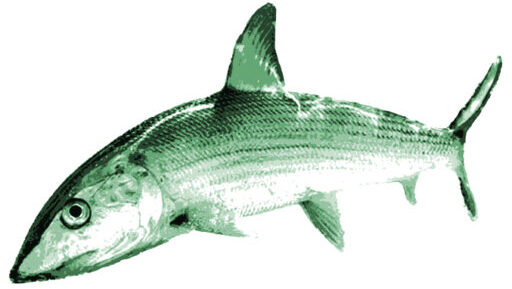
FFI フライキャスティング用語定義集 (FFI:Fly Fishing International) は、フライキャスティング教育プログラム定義編成チーム とフライキャスティング・メカニックスチームによってまとめられた公式の用語定義集です。これをベースにFFIの一般文献に出てくる用語に限定して、日本のフライフィッシャーに必要と思われるものを私の言葉で” マーク”でわかるように追加し、更に解説を” マーク”で加えました。フライキャスティングの学びへの扉となることが本用語集の狙いです。
The FFI Fly Casting Definition was compiled by the Fly Casting Definitions Team and the Fly Casting Mechanics Team in FFI. Respecting the original definitions, I have added supplemental casting terms, which are appeared in general FFI literature and I believe helpful for Japanese fly fishers marked with “ “, as well as explanatory notes with my own words marked with ” “. The aim of this glossary is to serve as a doorway to study the art of fly casting.
目次: Contents
ふらいフライフライらいフライフライフライフライキャスティングを始めるにあたって: Getting Started with Casting¥
⚫︎フライキャスティング: Fly Casting
[定義] 柔軟な「てこ」の役目を担うロッドを使って加重あるラインを操作し、これを繰り出すことで毛ばりを飛ばすこと。
[Definition] Using a flexible lever to move and unroll a weighted line to propel an artificial lure.
セットアップ・ポジション: Setup Position
[定義] キャストを開始する前のロッド、ライン、リーダー、フライ、及び立ち構え(スタンス)の初期位置。
基本は、ラインとリーダーは水面にまっすぐセットされ、スラックがない状態。ラインとフライは水面上または水面近くにセットされ、ロッドティップは水面ギリギリにセットする、のが基本形。
[Definition] The initial positions of the rod, line, leader, fly, and stance to start a cast.
By default, the line and the leader are set straight on the water or near the water surface with no slack and rod tip is set low to the water.
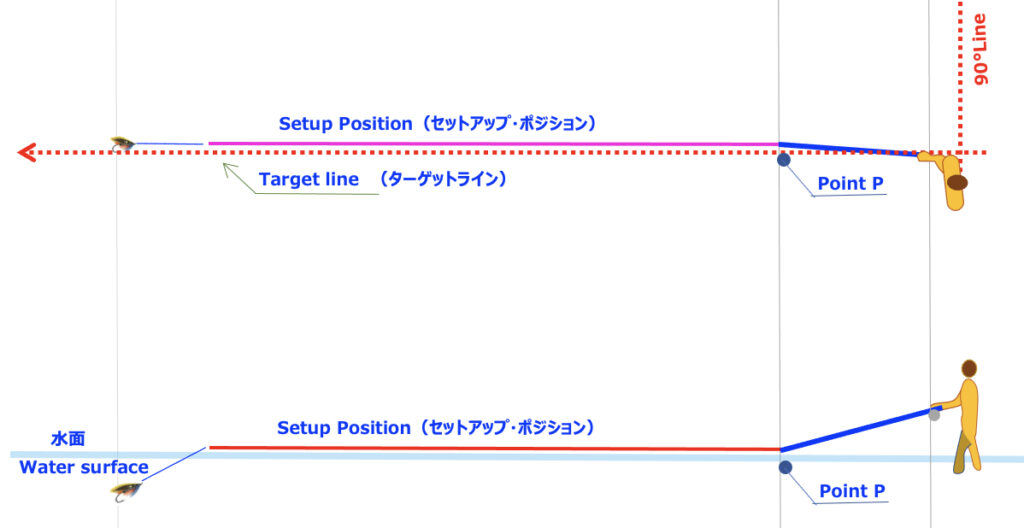
スタンス: Stance
[定義] キャストをしようとしているターゲットに対する構え。両足の位置が、クローズ、スクエア、オープン・スタンスの3つのポジションを基本とする。
オープン・スタンスは、キャスティング・ストロークが長く取れるのでディスタンス・キャストに向く。クローズト・スタンスは、腰の余分な横回転を抑えられることでトラッキング・エラーを抑え易い。また、下半身に対して上半身の捻転差(スプリング効果)で回転力をつけるスペイキャストは、クローズト・スタンスの方がロッドスイングが早くなるキャスターが多い。スクエア・スタンスは、アキュラシー性が高い。
[Definition] The caster’s stance in relation to the intended target of the cast. The positioning of the feet generally falls into one of three basic categories: closed stance, square stance, and open stance.
The open stance allows for a longer casting stroke, making it easier for distance cast. The closed stance reduces over rotation of hip move, making it easier to reduce tracking errors. Additionally, in Spey casting, where rotational power is generated through the torsional difference between the lower and upper body (the spring effect), many casters find that a closed stance allows for a faster rod swing.The square stance provides better accuracy.
グリップ: Grip
[定義] ロッドの動きをコントロールする上で極めて重要な要素の一つとなるフライロッドの握り方。
シングルハンド・ロッドでは、ロッドに対して親指が上に来るサム・オン・トップ。人差し指が上に来るインデックスフィンガー・オン・トップ。親指と人差しをVの字状に上に来るVグリップの3種類が一般的。また、ロッドハンドがコルクハンドルを握る位置も目的の違いによって、コルクハンドルの上部、中間部、リールに近い部分、の握り位置の使い分けがある。
[Definition] The ways to grip a fly rod, which is one of the most important key essences of rod movement control.
For single-hand rods, three primary grip styles are commonly used: Thumb-on-top, where the thumb is on top of the rod; Index-finger-on-top, where the index finger is on top; and V-grip, where the thumb and index finger form a “V” shape on top of the rod. Additionally, the position where the rod hand grips the cork handle can vary depending on the angler’s intent. Common grip positions include the upper part, middle section, and near the reel seat of the cork handle.
ダングル : Dangle
[定義] フライをスイング、あるいはドリフトし終えてロッドティップからぶら下がっているラインとリーダーの状態。また、次のキャストに向けてのセットアップポジションで、整えたラインの状態を意味する。
[Definition] It refers to the state of the line and leader hanging from the rod tip after finishing swing or drift the fly, and also the state of the line in the setup position for the next cast.

スラック : Slack
[定義] フライラインにできる”ゆるみや波状”をスラック、あるいはスラックライン”と言う。目的を持って意図的にラインにスラックをかける場合と、キャスト中に意図せずにスラックがラインに入ってしまいキャスティングに悪影響をもたらす場合がある。
意図的にスラックをかける場合は、水面上、あるいは水中をフライにドラグが掛からないようにドリフトさせたい場合に行う。また、スイングの釣りでは上流側にスラック(メンド)をかけて、ラインとフライが緩やかに深く水深層をスイングさせたい時に使用する。一方、キャスト中の空中にあるラインのループや、アンカードキャストにおいてDループに張りがなく弛んでいたり、波状のスラックが入っている状態は、コンスタントテンションと言うキャスティングの基本を満たすことができず、ネガティブなスラックと言うことになる。
[Definition] The looseness or waviness in a fly line is referred to as “slack” or “slack line. “Sometimes slack is introduced intentionally for a specific purpose, while other times it occurs unintentionally during the cast, which can have a negative impact on casting performance.
Intentional slack is introduced to allow the fly to drift naturally on or beneath the water’s surface without creating drag. For example, in swing fishing, an upstream mend adds slack to help the line and fly swing more slowly and deeply through the water column. In contrast, unintentional slack—such as wavy loops forming in the aerialized loop or a D-loop lacking proper tension in an anchored cast—disrupts the fundamental principle of constant tension in casting. This type of slack is considered undesirable and negatively affects performance.
トップハンド、ボトムハンド : Top Hand, Bottom Hand
[定義] ツーハンド・フライロッドを握る時に、コルクハンドルの上部を握る方の手をトップハンド、下部を握る方の手をボトムハンドと呼ぶ。キャスト時に右手を上でキャストする場合は「右手アップ、あるいは右手をトップ」、その逆を「左手アップ、あるいは左手をトップ」のキャストと言う。
トップハンドのグリップ位置は、通常、ロングロッド、ヘビーラインほどコルクハンドルの先端部の近く、ショートロッド、ライトラインほど、コルクグリップの中間部を握るのが一般的。またキャスティング・スタイルによっても異なる。スキャンディナビアン・アンダーハンド・キャスティングにおいては、トップハンドはコルクハンドルの中間部を基点に握る。一方、トラディショナル・スペイキャスティングでは、トップハンドはコルクハンドルの上端に来る。
[Definition] When gripping a two-hand rod, the hand that grips the top part of the cork handle is called the “Top Hand”, and the hand that grips the bottom is called the “Bottom Hand”. Casting with the right hand on top is called a “Right-hand Up or Right-hand on top” cast, and vice versa is called a “Left-hand Up or left-hand on top” cast.
The grip position of the top hand is generally closer to the front end of the cork grip for longer rods and heavier lines, while for shorter rods and lighter lines, it is more common to hold the middle section of the cork handle.The casting style also affects the grip position. In Scandinavian Underhand Casting, the top hand grips the middle section of the cork handle as the base. On the other hand, in Traditional Spey casting, the top hand is positioned at the upper end of the cork handle.
ロッドハンド、ラインハンド : Rod Hand, Line Hand
[定義] ロッドハンドは、ロッドを握っている方の手。ラインハンドは、ラインをホールドしている側の手を意味する。
[Definition] The rod hand is the hand that holds the rod. The line hand is the hand that holds the line.
⚫︎タイミング:Timing
[定義] 各キャスティングの動きにおいて、次のアクションに移行するその瞬間。
[Definition] The moments in time when each casting action transitions into the next.
⚫︎テンポ: Tempo
[定義] キャスティング サイクルを実行するペース。
[Definition] The rates of movement within a cast.
パワー, フォース: Power, Force
[定義] キャスティング ストロークの中でPower と Force は同じ意味で使われる。 パワーと言う表現は一般的であるが、FFI ではより意味合いとして正しい言葉である「フォース」の使用を推奨している。
[Definition] In casting strokes, Power and Force are interpreted interchangeably. Although Power is a common term, FFI recommends the use of Force, as it is the more correct word.
スーピネーション, プロネーション: Supination, Pronation
[定義] プロネーションとは回内捻転、スーピネーションとは回外捻転と言うスポーツでの一般用語。例えば、キャストをし終えた時に、ロッド保持している手の平が内向きに内捻転して空を向く状態をプロネーション。逆に手の甲が空を向く状態をスーピネーションと言う。
トラッキング・エラーを起こしているキャスターに、プロネーションはよく見られる。 また、これを意図的に使う場合もある。例えば垂直軌道を使ったカーブキャストでは、左右どちらにカーブをかけるかによって、プロネーション、あるいはスーピネーションのどちらかのリストの動きが入る。
[Definition] General terms in sports. For example, upon finishing the cast, when the palm of hand holding the rod is rotated inward and facing the sky it is claaed pronation. Conversely, the back of your hand is called supination.
Pronation is commonly seen among the casters who cause Tracking Error. This twisting can also be used intentionally. For example, when performing a “curve cast” with a vertical casting trajectory, the wrist movement will be either pronation or supination, depending on whether the curve is applied to the left or right.
⚫︎フォルスキャスト: False Cast
[定義] フォワードキャストに続くバックキャストの両方において、ラインを空中に保つキャスト。
[Definition] A forward cast followed by a back cast, both of which remain aerialized.
⚫︎デリバリー・キャスト: Delivery Cast
[定義] 一連のキャスティング動作の中で、フライをプレゼンテーションするために行う最後のストローク。
オーバーヘッド・キャストにおいても、アンカード・キャストにおいても、デリバリーキャストのキャスティング・フォームは同じ。
[Definition] The final Casting Stroke of a Fly Cast, which presents the fly.
Whether it’s an overhead cast or an unanchored cast, the casting form for the delivery cast stays the same.
⚫︎コンティニュアス・テンション・キャスト: Continuous Tension Cast
[定義] 継続的なロッドの動きにより、フライラインのテンション(張り)を常に維持させるキャスト。
アンカードキャストの全てが、コンティニュアス・テンション・キャスト。オーバーヘッド・キャストにおいてはオーバルキャストが典型的なコンティニュアス・テンション・キャスト。但し、通常のオーバーヘッド・キャストにおいても、常にラインが空中にある限りにおいては、テンションは保った状態でキャスティングされているので、その意味でコンティニュアス・テンション・キャストは全てのキャスティングに通用する基礎とも言える。
[Definition] A cast where continuous rod movement maintains tension in the fly line.
All anchored casts are continuous tension casts. In overhead casting, the oval cast is a typical continuous tension cast. However, even with normal overhead casting, as long as the line is in the air, tension is maintained during casting, so in that sense continuous tension casting can be said as the foundation that applies to all casting.
⚫︎シューティング・ライン: Shooting line
[定義] ロッドストップの後にラインをリリースすることで、ロッドティップから出たフライラインの長さを伸ばすための動作。
[Definition] Increasing the amount of fly line outside the rod tip by releasing the fly line after the Stop.
⚫︎スリッピング・ライン: Slipping line
[定義] キャスティング・ストロークを始める前、ないし終了した後でラインをリリースしロッドを動かすことでロッドティップから出るフライラインの長さを伸ばす動作。
リーチメンドを使用する際、ターゲットに正確にフライを落とすためラインをスリップさせて距離を調整する際に多用される。別用途として、バックキャストでホールをかけた後のポーズ中にラインをスリップさせロッドティップから出ているラインの長さを伸ばす際にも使われる。
[Definition] Increasing the amount of fly line outside the rod tip by releasing the fly line and moving the rod either before or after a Casting Stroke.
When using the Reach Mends, slipping the line to adjust the line length for accurately drop the fly on the target is frequently employed. As an alternative use, it is also utilized during the pause after hauling on the backcast to extend the length of the line coming out of the rod tip.
⚫︎オーバーハング: Overhang
[定義] キャスティングストローク中にロッドティップの外側に出しておくランニング/シューティング ラインの部分。
通常、ロングキャストする時ほどオーバーハングを長く取るが、その長さには常識的な限界点がある。適切な長さのオーバーハングは、カンターフレックスによる振幅を吸収するため、ナローループを助長し、よってロングキャストに繋がる。通常の長さは、30cmから90cm程度。長くなり過ぎると、ロッドのパワーがラインに伝達しにくくなる。また長めのツーハンドロッド(14ft以上)に短いシューティングヘッド(スカジット、ショートスキャンディ・ライン等)を使うアンカードキャストの場合、ロッドティップから出ているライン全長を伸ばせるのは、適切なアンカーの長さを確保する上でメリットとなる。ディープウェーディングする時は、オーバーハングの長さを通常より短めに調整する。
[Definition] The amount of running/shooting line outside the rod tip during Casting Strokes.
Generally, the longer the cast, the longer the overhang, but there is a common sense limit to that length. With the proper length of overhang, the amplitude from counterflex is absorbed, the loop narrows, and casting distance increases.The usual length is about 1 to3ft. If it is too long, it becomes difficult to transmit the power of the rod to the line. Additionally, when using a longer two-hand rod (14ft+length) and a short shooting head (e.g.Skagit or short Scandi line), the adjustment to extend the total length of the line outside the rod tip will be an advantage for placing appropriate anchor length.” When deep wading, adjust the overhang length shorter than usual.
ペイロード : Payload
[定義] デリバリーキャストにおいて、フライと必要に応じて選択するシンクティップラインをキャスティングによってデリバリーする ”フライライン” の重量運搬能力を言う。
スカジットラインは、重いシンクティップと、比重の高いフライをキャストできるようデザインされている。その意味で、スカジットラインは「ハイ・ペイロード(高い運搬能力)のライン」となる。 同様にライン番手の大きいオーバーヘッドキャスト用の短く太いウェイトフォワードラインも、ハイ・ペイロードなラインと言うことができる。こうしたハイ・ペイロードのラインは風に対して比較的強いと言うアドバンテージもあるが、遠投性能は幾分落ち、静かなプレゼンテーションを求める時には弱みが出る。 逆に全長が長く、細く、番手の軽いフライラインは、ペイロードは低く風には弱いものの、条件が整っていればロングキャストに向き、ソフトなプレゼンテーションができるライン、と言うことになる。
[Definition] In a delivery cast, this refers to the weight-carrying capability of the fly line, which delivers the fly and, when necessary, a selected sink-tip line through casting.
The Skagit line is designed to cast heavy sink tips and high-density flies. In that sense, the Skagit line is a “high-payload line.” Similarly, short and thick weight-forward lines with large line weights for overhead casting can also be considered high-payload lines. Such high-payload lines have the advantage of being relatively wind-resistant, but their long-distance casting performance tends to suffer, and they are less suited for delicate presentations. Conversely, long, thin, and lightweight fly lines have lower payload capacity and are more affected by wind, but under the right conditions, they are ideal for long casts and enable soft, subtle presentations.
オーバーライニング、アンダーライニング : Overlining, Underlining
[定義] オーバーラインニングとは、ロッドメーカー指定のフライラインの番手よりも意図的に重いラインでキャストすること。アンダーラインニングは、逆に軽いフライラインでキャストすること。
フラッツのボーンフィッシングでは、中心の射程距離は9-15Mが中心であることが多い。 その際、ダンベルアイ付きの比重の重いフライはペイロード(運搬能力)の高いラインで投げる方が有利、つまり一番手重いラインを使う、と考えるキャスターも多い。また、シングルハンド・ロッドでスペイキャスティングをする場合には、ロッドメーカー指定のライン番手よりも通常1から2番手重めのラインを使うのがタックルバランスが良いのが普通である。 逆に、中心射程距離が常に20M以上になるような場合でドライフライやニンフをデリケートなプレゼンテーションで投げる場合は、アンダーラインニングを好むキャスターもいる。
[Definition] Overlining refers to casting with a fly line that is intentionally heavier than the one recommended by the rod manufacturer. Underlining, on the other hand, means casting with a lighter fly line than specified.
In flats bonefishing, the typical casting range is often centered around 30 to 50 feet. In such situations, it is advantageous to cast heavy dumbbell-eyed flies using a line with high payload capacity—many casters believe in using a line one size heavier than standard. When performing Spey casting with a Single Hand rod, it is generally standard practice to use a line that is one to two line weights heavier than what is recommended by the rod manufacturer, as this typically results in better tackle balance.Conversely, when the standard casting distance consistently exceeds 65 feet and the situation calls for delicate presentations with dry flies or nymphs, some casters prefer underlining.
ループ: Loopssss
[定義] キャスト中、フライラインがロッドティップを追い越すときに出来るラインの形状
[Definition] The shape a fly line assumes as it overtakes the rod tip during a Fly Cast.
ワイドループ、ナローループ: Wide Loop, Narrow Loop
[定義] ループのフライレグとロッドレグの間隔が大きいものをワイドループ、間隔が狭いものをナローループと言う。
ワイドループは、通常、ロングリーダー、比重の重いフライ、リーダーに複数のフライを装着してキャストする場合に適用される。ナローループは、ロングキャスト、正確さを求める時、エリアルメンドを行う場合に使われる。
[Definition] A loop with a large gap between the fly leg and the rod leg is called a Wide Loop, while a loop with a small gap is called a narrow loop.
Wide loops are usually used when casting long leaders, heavy flies, or multiple flies attached to a leader, while narrow loops are used for long casts, accuracy casts, and when applying aerial mends.
ループのパーツ名称: Loop Parts Name
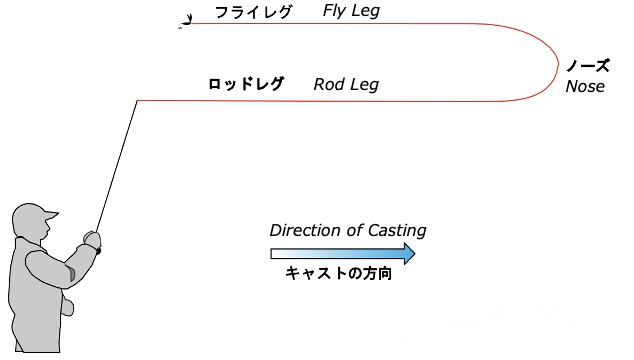
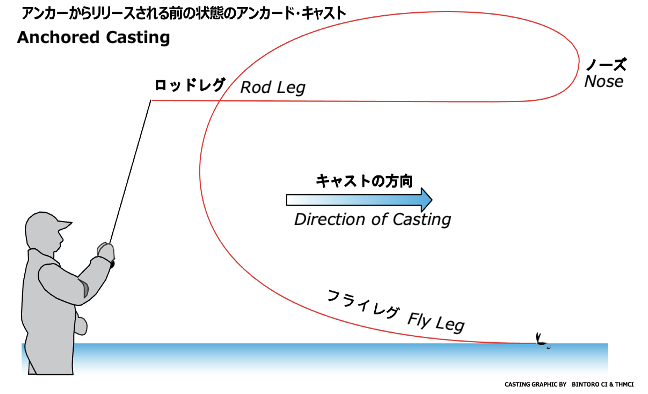
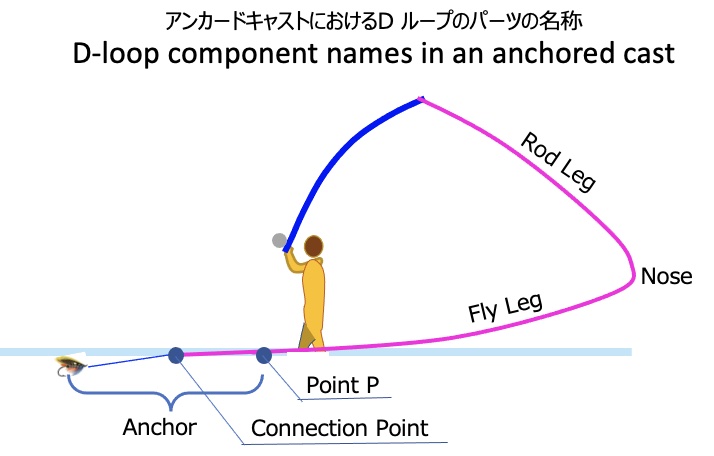
⚫︎フライレグ:Fly Leg
[定義] ループにおいて、フライからループノーズまでの常に動いている部分。
フライレグはループの中で最も速く移動する部分であり、キャスティングの成否に最も影響する部分。その最大効果を得るためには、フライレグが直線状 (ストレート・フライレグ)である必要がある。
[Definition] The moving section of fly line in a loop from the fly to the start of the loop nose.
The fly leg is the fastest moving part of the loop and has the biggest influence on the success of the cast.To be most efficient, the Fly Leg should be nearly straight(Straight Fly Leg).
⚫︎ロッドレグ:Rod Leg
[定義] ループにおいて、ロッドティップからループノーズまでの動いている部分、あるいは静止している部分。
ロッドレグは遅い速度で動くことで、先行してより速く動くフライレグに抵抗をもたらすことで、これがループのターンオーバーを促す原動力となる。
[Definition] The moving or stationary section of fly line in a Loop from the rod tip to the end of the Loop Nose.
The slower moving rod leg provides resistance to the faster moving fly leg and helps generate propulsion to roll out the loop.
⚫︎ループノーズ:Loop Nose
[定義] ループの前方部で、フライレグとロッドレグをつなぐフライラインの湾曲部分。
ループノーズは、最も空気抵抗を受けるポイントであり、その幅が倍になると空気抵抗は二乗の4倍程度になり得る。空気力学的に最高率を求めるには、ノーズ形状が尖っており、鋭角であることが理想である。
[Definition] The curved section of fly line at the front of the Loop which is the transition between the Fly Leg and the Rod Leg.
The loop nose is the point where air resistance is greatest, and doubling its width can increase air resistance by about four times the square. To achieve the highest aerodynamic efficiency, the nose shape should ideally be pointed and have an acute angle.
⚫︎トラジェクトリー: Trajectory
[定義] 水平線に対するループの射出方向。
射出軌道=トラジェクトリーはターゲットまでの距離、及び風向きによって変動する。近距離を狙う場合、及び向かい風の場合は、高いバックキャストの後、ターゲットに対して鋭角に水面方向を狙う。距離が増すにつれて角度は水平に近づき、ロングキャスト、及び追い風の場合は、最適な射出角は水平線よりも高くなる。
[Definition] The direction travelled by the Loop relative to the horizon.
The launch trajectory varies depending on the distance to the target and the wind direction. For short-range targets and headwinds, a high backcast followed by a sharply angled approach toward the water surface is ideal. As the distance increases, the angle becomes more horizontal, and for long casts or tailwinds, the optimal launch angle is higher than the horizon.
⚫︎トラッキング: Tracking
[定義] キャスティングストロークにおけるロッドティップの水平面上の軌跡。
「トラッキング・エラー」を参照。
[Definition] The lateral path of the rod tip during the Casting Stroke.
See “Tracking Error“.
⚫︎ロッド・ティップパス: Rod Tip Path
[定義] キャスト中にロッドティップが移動する直線または曲線の経路。
「フライキャスティングにおける5つの必須項目」を参照。
[Definition] The straight or curved path travelled by the rod tip during a Fly Cast.
フライレグの形状: Fly Leg Shapes
⚫︎ストレート・フライレグ:Straight Fly Leg
[定義] ループノーズの先端からフライまで、ラインとリーダーがほとんど湾曲していない直線状のフライレグ。
キャスティングの効率を最大限に高めるには、ストレート・フライレグであることが基本となる。
[Definition] A Fly Leg where the fly line and leader are relatively free from curvature from the Loop Nose to the fly.
To maximize casting efficiency, it is essential that the fly leg is as close to straight as possible.

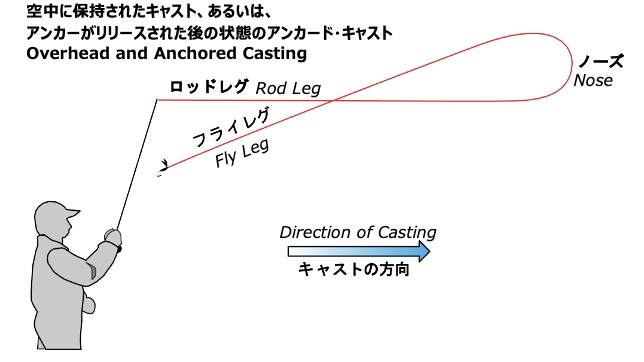
⚫︎コンベックス(凸型)・フライレグ:Convex Fly Leg
[定義] ロッドレグに対してドーム状に湾曲した状態のフライレグ。
コンベックス・フライレグは、キャスティングの効率を下げるため、より直線に近いストレート・フライレグに修正することが求められる。
[Definition] A Fly Leg with a dome shaped configuration curving away from the Rod Leg.
A convex fly leg reduces casting efficiency, and it is expected to be modified to be a straight fly leg.
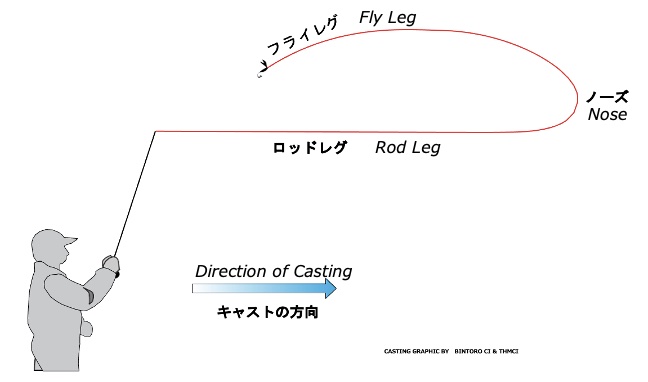
⚫︎コンケーブ(凹型)・フライレグ:Concave Fly Leg
[定義] 直線状でなく、ロッドレグ側に凹んでいる状態のフライレグ。
コンケーブ・フライレグは致命的な問題は起こさないが、 ストレート・フライレグに比べラインの空気抵抗が増し、ループの推進力も低下する。原因は、ストローク中にロッドティップが直線軌道を通過していないことによる。
[Definition] A Fly Leg which is not Straight and dips toward the Rod Leg.
A concave fly leg does not cause fatal problems, but compare to the straight fly leg it increases the air resistance and reduce the propulsion of the loop.The reason of this cause is that the rod tip is not moving in a straight line during the casting stroke.
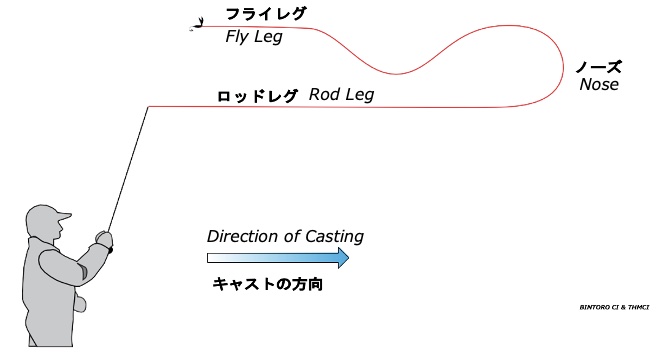
⚫︎トレイリング・ループ:Trailing Loop
[定義] フライレグがコンケーブ(凹型)でなくロッドレグと交差しているループ。
オーバーヘッド・キャスティングでは、トレイリング・ループはキャスティングにおいて特段の悪影響はもたらさない。アンカード・キャスティングでは、必然的に形成されるループ位置となる。
[Definition] A Loop with a Concave Fly Leg, which dips towards and crosses the Rod Leg.
In overhead casting, the trailing loop does not have any particular adverse effect on casting. In anchored casting, this is a loop position that is formed inevitably.


⚫︎テイリング・ループ:Tailing Loop
[定義] フライレグがコンケーブ(凹型)形状で、ロッドレグに交差するループ。
「テイリング・ループ・エラー」を参照。
[Definition] A Loop with a Concave Fly Leg, which dips towards and crosses the Rod Leg.
See “Tailing Loop Casting Error“.
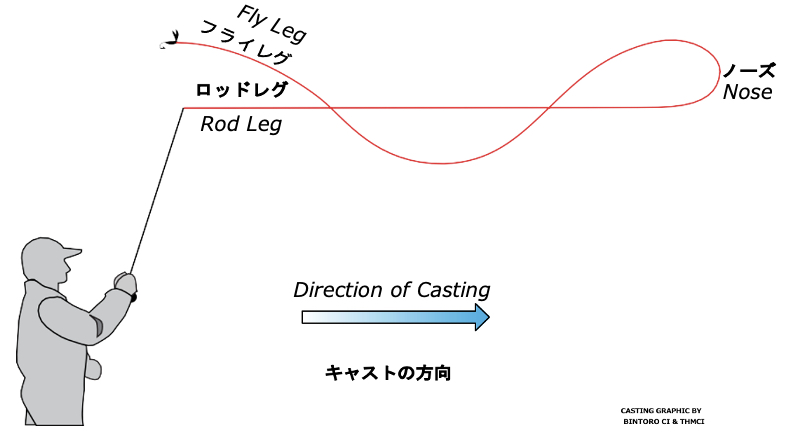
⚫︎アンダースラング・ループ:Underslung Loop
[定義] フライレグがロッドレグの下側を展開していくループ。
アンダースラング・ループは、ラインの先端が空に向かってターンするので、バックキャストのループがバックの地面や水面を叩きにくく、また、デリバリーでも静かにプレゼンテーションできるメリットがある。 通常、オーバーヘッド・キャストでシューテイング・ヘッドを使う場合は、フォルスキャストはアンダースラング・ループでキャストされる。
[Definition] A Loop whose Fly Leg unrolls below its Rod Leg.
By casting Under Slung loop the line tip turns toward the sky, preventing the backcast loop from hitting the back. This also allows for a quieter presentation on delivery. Generally when using a shooting head for overhead cast, the false cast is made with underslung loop.
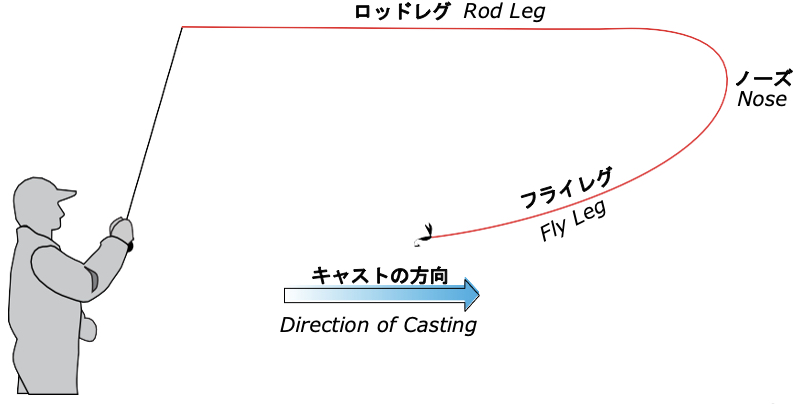
キャスティング・プレーン: Casting Plains
⚫︎ロッド・プレーン: Rod Plane
[定義] キャスト中にロッドがたどる面。
キャスティング・ストロークが始まってからロッドがストップするまでのロッドがなぞる面は同一面である必要があり、元の面から逸脱するとキャスティング効率は落ちる。 「アウトオブ・プレーン・ループ」を参照。
[Definition] The surface traced by the rod during a Fly Cast.
The plane traced by the rod from the beginning of the casting stroke to the rod stop must remain consistent; deviating from the original plane reduces casting efficiency. See “Out-of-Plane Loop”.
⚫︎インプレーン・ループ (プレーン上に乗っているループ): In-Plane Loop
[定義] フライレグとロッドレグが同一プレーン(平面)にあるループ。
日頃から常にキャスティング・プレーンがサイド気味にキャストする人はひじょうに多いが(下の図の緑のプレーン)、注意すべきは、サイド気味のプレーンだとプレーンから外れていることに気づいていない人が多い。練習の時は、完全な垂直プレーンから開始しすることも有効。
[Definition] A Loop whose Fly Leg and Rod Leg are in the same plane.
Many people tend to cast with a side-angled casting plane on a regular basis (as shown by the green plane in the diagram below). However, it’s important to note that with a side-angled plane, many fail to realize that their cast is off-plane. During practice, starting with a perfectly vertical plane can be very effective.
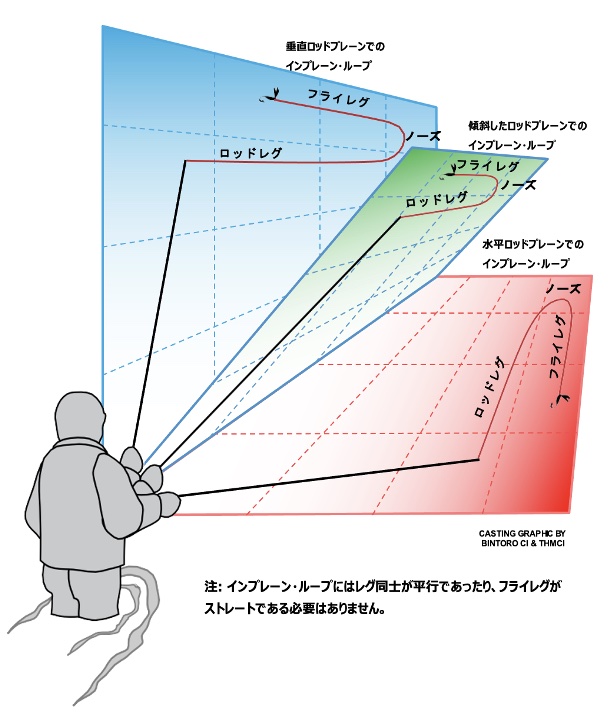
⚫︎アウトオブ・プレーン・ループ (元のプレーンから外れているループ): Out-of-Plane Loop
[定義] フライレグとロッドレグが別のプレーン(平面)にあるループ。
キャスティング・プレーンが元のプレーンから逸脱するミスは殆どの入門者に見られる失敗例で、これをトラッキング・エラーと呼ぶ。トラッキングを意図的に外して投げる唯一の例外は、ロッドをほぼ垂直面でスタートして湾曲させたラインをプレゼンテーションする「カーブキャスト」のキャスト法となる。
[Definition] A Loop whose Fly Leg and Rod Leg are in different planes.
A deviation of the casting plane from the original plane is a common mistake seen in most beginners, and this is called a tracking error. The only exception where tracking is intentionally altered is the casting technique called the “curve cast,” in which the rod starts in a nearly vertical plane and presents a curved line.
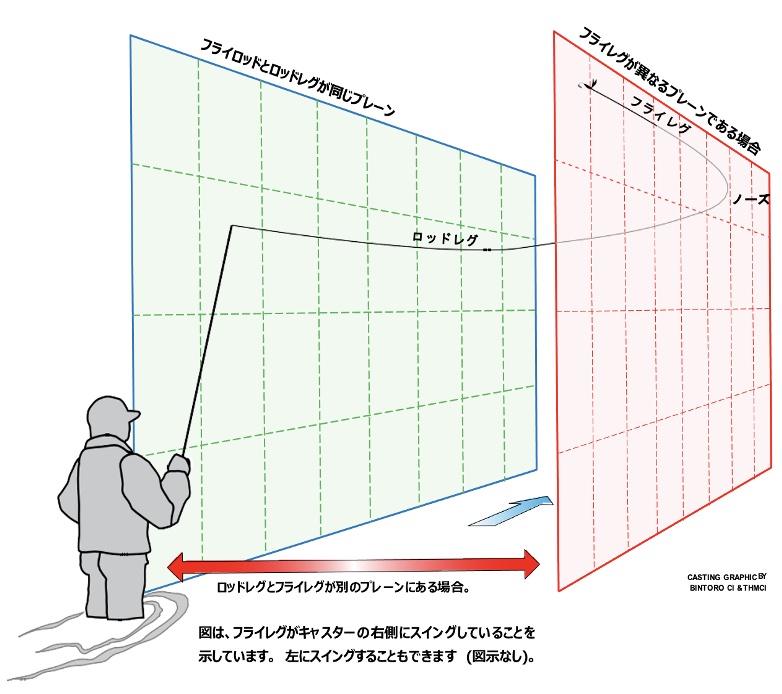
オンサイド・キャスト、オフサイド・キャスト: Onside Cast, Offside Cast
[定義] オンサイドキャストとは利き手側のプレーン(面)にループを通すキャスト。オフサイドキャストは逆手側のプレーン(面)にループを通すキャスト。
オフサイド・ループは、通常、利き腕に向かって風が吹いている時に、フライが自分にヒットするのを回避する目的でオフサイド側(逆手、風下側)にループを通したい時に使用する。
[Definition] An onside cast is when the loop is formed on the caster’s dominant hand, and an offside cast is on the opposite.
An offside cast is usually used when the wind is blowing towards caster’s dominant hand and you want to have your loops passing your offside (away from you, downwind) to avoid the fly hitting you.
フライキャスティングの動作: Fly Casting Movements
キャスティング・ストローク内の動作: Movements Within the Casting Stroke
⚫︎キャスティング・ストローク: Casting Stroke
[定義] ループを形成するのにじゅうぶんな、ロッドバット部のローテーション及びトランスレーション。
⚫︎オーバーヘッドキャスティングにおける、キャスティング・ストローク内の動作 = トランスレーション(ローディング) + ローテーション (アンローディング)」 *バックキャストストロークとデリバリー(フォワード)キャストストロークは共にキャスト方向が違うだけで同じモーションとなる。
⚫︎アンカードキャストのキャスティング・ストロークは、バックキャストストロークとデリバリー(フォワード)キャストストロークの両方を個別に語ることになる。 また、ツーハンドロッドの場合は、トップハンドのストロークとボトムハンドのストロークも別々に語られることになる (下図を参照)。 アンカードキャストのバックキャスト・ストロークは、Dループスイープ、サークルアップ。 デリバリー(フォワード)キャストのストロークでは、オーバーヘッドキャストと同じ、トランスレーション(ローディング) + ローテーション (アンローディング)となる。
[Definition] Rotation and/or Translation of the rod butt sufficient to cause Loop formation.
⚫︎In overhead casting, the casting stroke consists of Translation (Loading) and Rotation (Unloading). *The backcast stroke and the delivery (forward) cast stroke share the same motion—the only difference is the direction of the cast.
⚫︎In the anchored cast, the casting stroke is discussed by separately seeing both the back cast stroke and the delivery (forward) cast stroke. Also, in case of two-hand rod casting it will be addressed simultaneously in relation to both the top-hand and bottom-hand strokes.(See diagram below.) The back cast stroke is a D loop sweep and a Circle up. The delivery (forward) cast stroke is the same as the overhead cast, Translation (Loading)+ Rotation (Unloading).
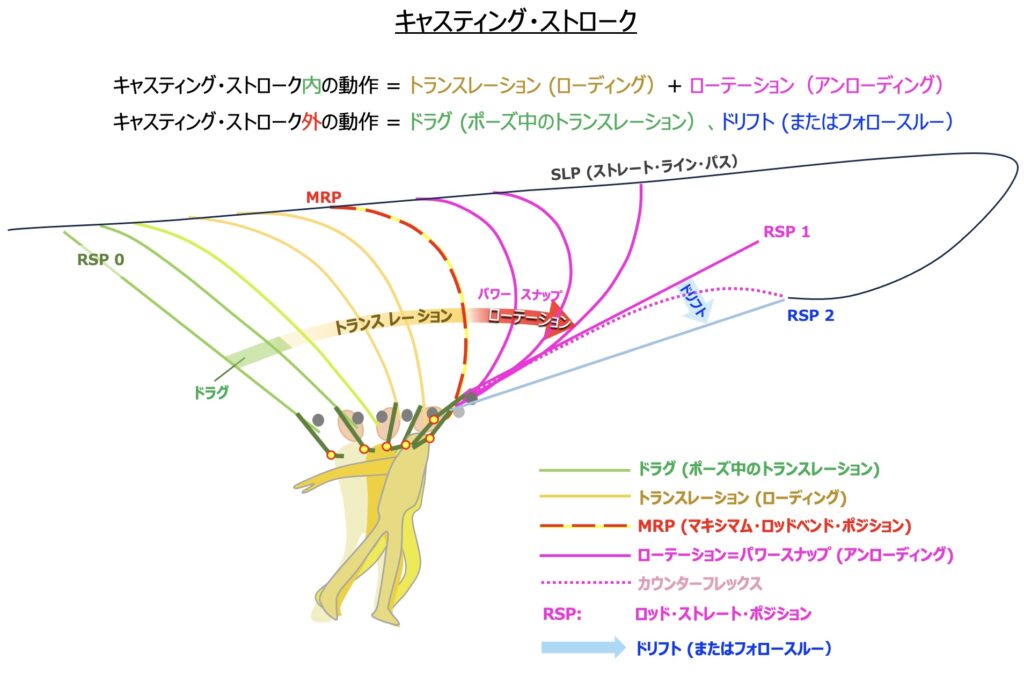
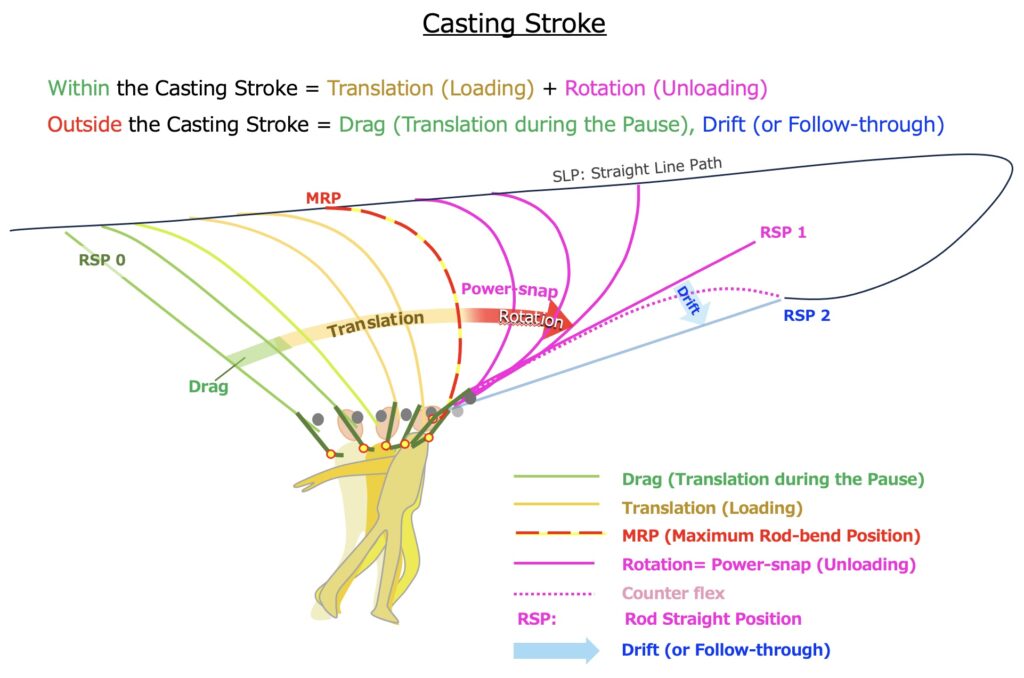
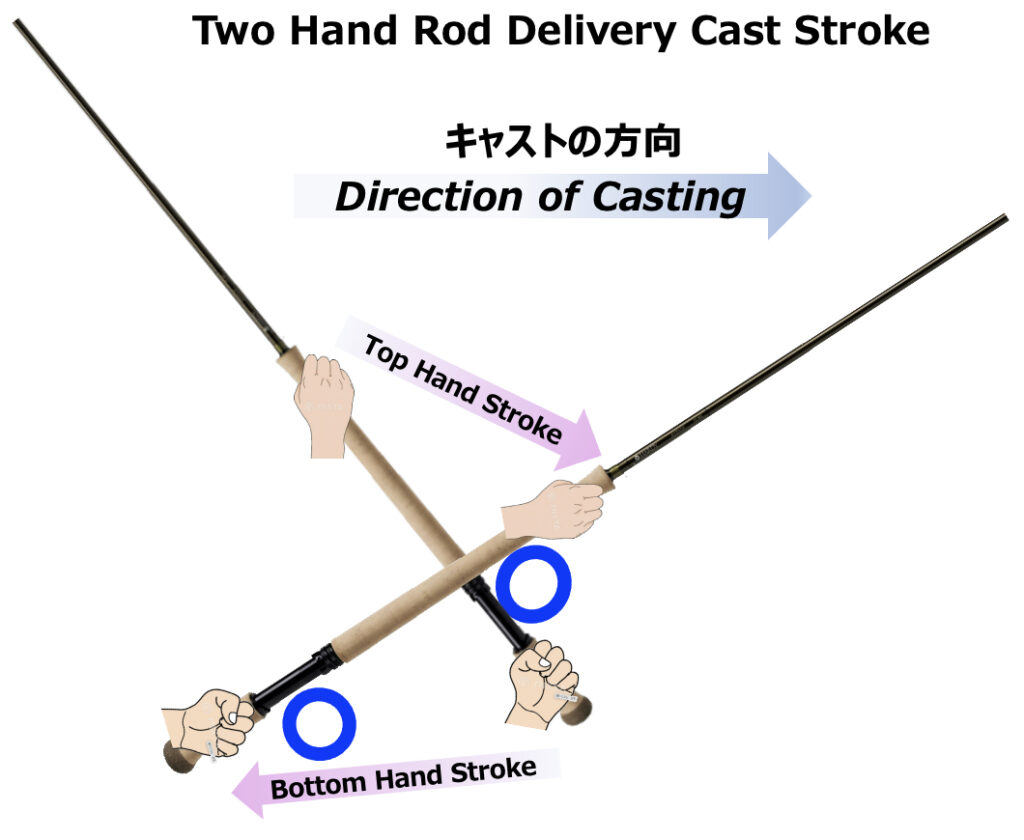
⚫︎トランスレーション:Translation
[定義] 並進運動によってロッドバットの位置を変えること。
ストローク中におけるトランスレーションは、ロッドを曲げる(ベンドさせる)ことが主な目的。この意味でトランスレーションは、ロッドにエネルギーを蓄えるローディングの部分と一致する。トランスレーションの最後にロッドは最大限に曲がるポイント MRP (マキシマム・ロッドベンド・ポジション)に来るのが理想。
[Definition] A linear change in position of the rod butt.
During the stroke, the primary purpose of the translation is to bend (load) the rod. In this sense, the translation phase corresponds to the loading phase in which energy is stored in the rod.Ideally, at the end of the translation, the rod should reach the MRP (Maximum Rod-bend Position).
⚫︎ローテーション:Rotation
[定義] 回転運動によってロッドバットの位置を変えること。
ロッドがMRP (マックス・ロッドベンド・ポジション)に到達するとトランスレーションのフェーズは終了し、今度は、ローテーションのフェーズに入る。ここで急加速するほどラインスピードが増すことになる。トランスレーションのフェーズでエネルギーがロッドに十分に蓄積され、ローテーションのフェーズでそのエネルギーがフライラインに一気に放出(=アンロード)されることにより、フライラインが前進する推進力を得ることになる。
[Definition] An angular change in position of the rod butt.
Once the rod reaches the MRP (Maximum Rod-bend Position), the translation phase ends and the rotation phase begins.The more abruptly this rotation is accelerated, the greater the resulting line speed will be. By storing sufficient energy in the rod during the translation phase, and then fully transferring—Unloading—that energy into the fly line during the rotation phase, the fly line gains the propulsive force that drives it forward.
ロッドストレート・ポジション : Rod Straight Position (RSP)
[定義] 一連のキャスティングストロークの中で、ラインの加重と慣性で一旦曲がったロッドが真っ直ぐに戻った状態の位置。
通常、曲がったロッドはストップ後にロッドストレート・ポジションを一旦経由した後も、そのまま慣性でロッドティップは動き続け、カウンターフレックスを生む。そして再度ロッドストレート・ポジションに戻り完全静止する。
[Definition] During a series of casting strokes, the rod returns to a straight position after being bent due to the weight of the line and inertia.
Normally, after the stop, a bent rod passes through the RSP (Straight Rod Position) momentarily but continues to move due to inertia, creating a counter-flex. It then returns to the RSP again and comes to a complete stop.
マキシマム・ロッドベンド・ポジション: Maximum Rod-bend Position (MRP)
[定義] 一連のキャスティングストロークの中で、ロッドが最大限に曲がる位置。
ロッドはストロークの中でトランスレーションのフェーズの終わりで最大限に曲げられている(MRP)のが理想。この位置以降はローテーションのフェーズに移行し、ロッドのバット部は急減速するもロッドティップは更に加速することになる。この意味においてMRP(マキシマム・ロッドベント・ポジション)は重要な分岐点になる。 尚、MRPは、FFIの公式認定用語ではないが、フライキャスティングのメカニックスを語る上で極めて重要であるため本稿では取り上げることにした。
[Definition] The point within a sequence of casting strokes at which the rod bends to its maximum.
Ideally, the rod should be maximally bent (MRP: Maximum Rod Bend Position) at the end of the translational phase of the stroke.After this point, the motion shifts into the rotational phase — the rod butt decelerates rapidly, while the rod tip continues to accelerate. In this sense, the MRP represents an important transition point.Although MRP is not an officially recognized term by the FFI, it is an important concept in discussing the mechanics of fly casting, and is therefore used in this paper.
⚫︎ストローク・レングス: Stroke Length
[定義] キャスティング・ストローク中にロッドバットが移動する距離。
ストローク・レングスは2つの要素によって変動する。一つは、 キャストする距離。距離が長いほど、ストロークを長くとる。もう一つは、ロッドのアクションによる違い。スローテーパーのロッドは、ファーストテーパーのロッドに比してより大きいローテーション角(回転運動)でキャストする。一方、ファーストテーパーのロッドは、スローテーパーのロッドに比してより長いストローク・レングスでキャストすることになる。 ツーハンドロッドの場合は、ストローク・レングスは、トップハンドとボトムハンドの両方についてそれぞれ語ることになる。
[Definition] The distance moved by the rod butt during the Casting Stroke.
Stroke length varies depending on two factors.The first is the casting distance — the longer the distance, the longer the stroke should be.The second factor is the rod’s action. A slow-taper rod is cast with a larger rotation angle (rotational motion) compared to a fast-taper rod.Conversely, a fast-taper rod is cast with a longer stroke length than a slow-taper rod.In the case of a two-handed rod, stroke length is discussed separately for both the top hand and the bottom hand.
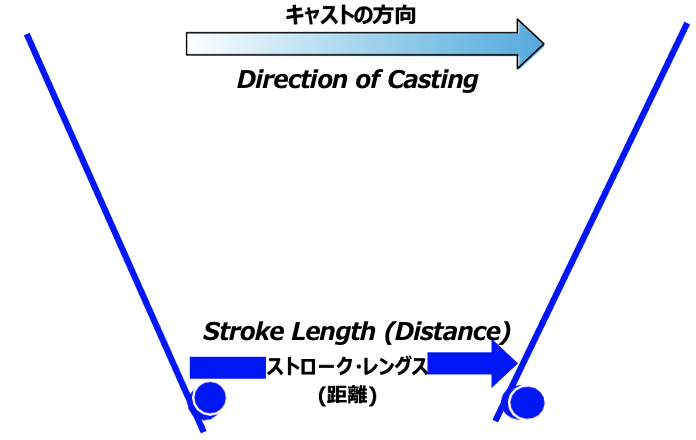
⚫︎キャスティング・アーク (角度):Casting Arc
[定義] キャスティングストローク中のロッドバット部の角度変化。
[Definition] The angle change of the rod butt during the Casting Stroke.

⚫︎キー・ポジション: Key Position
[定義] デリバリーキャストを開始する手と腕の位置。
キー・ポジションの位置は、オーバーヘッドキャスティングの場合、シングルハンド、ツーハンドロッド共にロッドハンドが耳の高さに来るのが基本形。(例外として、スカジットキャスト、スカンジナビアン・アンダーハンドキャストによるツーハンドロッド場合は、それより30cm下に来るにが通常。)
[Definition] The hand and arm positions from which the caster begins the Delivery Cast.
In overhead casting, whether using a single-hand or two-hand rod, the key position typically places the rod hand at ear level. (As an exception, in the case of using a two-handed rod with the Skagit cast or Scandinavian underhand cast, it is common for the line to come about 1foot lower than that.)
カウンターフレックス: Counter Flex
[定義] 通常、ストローク中にフルベンドの達したロッドはアンロードしながらにRPS (ロッドストレート・ポジション)を一旦経由した後も、そのまま慣性でロッドティップは下向き動き続け、ループの進行方に向けて曲がる。この曲がりの状態をカウンターフレックスと言う。
カウンターフレックスが激しいと、デリバリーされるループが不用意にワイドループになってしまう場合がある。 経験あるキャスターは、デリバリーキャストでカウンターフレックスを経由せずに一発でRSPに持って行くこともできる。
[Definition] During a casting stroke, a fully bent rod begins to unload and briefly passes through the Rod Straight Position (RPS). However, due to inertia, the tip of the rod continues to move forward then bends downwards when it reaches the RSP.This bending state is referred to as the counter-flex.
When the counter-flex is excessive, the delivered loop may unintentionally become a wide loop. Experienced casters can sometimes bring the rod directly to the RSP during the delivery cast without passing through the counter-flex phase.
⚫︎加速: Acceleration
[定義] 時間とともに速度が変化する割合のこと。これは正にも負にも、またはゼロにもなりうる。
ストローク開始時から、終了点=ロッドティップの移動が完全にストップするポイント、に至るまで、徐々にロッドティップの移動スピードを上げていくこと。 「スムーズな加速」は「パワースナップ」と並んで空気力学的に最適なループ形状を作る上で加速を語る時に要となる。変則的な力を加えてしまうと、フライレグに凹みやスラックが入る不効率なループ形状にもたらす原因となる。
[Definition] The rate at which velocity changes over time. It may be positive, negative or zero.
Gradually increase the speed of the rod tip movement from the start of the stroke until the endpoint, where the rod tip’s movement comes to a complete stop.”Smooth Acceleration” along with “Power-snap” is a key factor when discussing acceleration in creating an aerodynamically optimal loop shape. Applying irregular forces can cause dents and slack in the fly leg, resulting in an inefficient loop shape.
パワースナップ, ワンプ: Power-snap, Whump
[定義] ロッドにパワーがローディングされ、ロッドはフルベンドに達する。続いてクイック・リストローテーション(回転運動)によって加速が最高点に達した時点で、ロッドに貯め込まれたエネルギーはフライラインに対して一気に放出されることになる。このクイック・リストローテーションの動きをパワースナップ、あるいはワンプと呼ぶ。
パワースナップ、ワンプ共にFFIの公式用語ではないが、キャスティング・ストロークの中で「スムーズな加速」と並んで、最も重要な力のかけ方を表す言葉であるため、本稿ではFFIの文献では使われていないこの2語をリストに載せることとした。パワースナップはジョーン・ウルフ、ワンプはメル・クリーガーが普及させた表現。ワンプはロンドンのハーディー・キャスティングスクールで伝統的に使われて来た表現でもある。
[Definition] The force is loaded into the rod, and as the rod reaches its full bend, the energy stored in the rod is explosively released into the fly line while adding maximum acceleration through high speed quick wrist rotation. This quick wrist rotation movement is called a “Power-snap” or “Whump.”
Neither Power-snap nor Whump are official FFI terms, but since they are two of the most important ways to apply force in a casting stroke, along with “smooth acceleration,” I have decided to include these two terms as an exception not used in FFI literatures. ‘Power-snap’ was popularized by Joan Wulff, while ‘Whump’ was by Mel Krieger. The term ‘Whump’ had also been traditionally used at Hardy Brothers’ The School of Casting in London.
⚫︎ストップ: Stop
[定義] ループの生成につながるロッドの減速。
ストローク中にマキシマム・ロッドベンド・ポジション (MRP)に達したロッドは、アンロードしながらロッドのバット部は減速しつつもロッドティップは更に加速し続け、ロッドが真っ直ぐになる RSP (ロッド・ストレート・ポジション)の位置でロッドティップの移動スピードは最高速からいきなりゼロ, “=この瞬間をストップと言う“, となり、ロッドの慣性エネルギーがラインに移行することでラインの推進力となる。ストップさせるために”ブレーキをかける”と言う動作はない。
[Definition] Deceleration of the rod resulting in Loop formation.
During the stroke, as the rod reaches maximum rod-bend position (MRP), it begins to unload—while the butt section of the rod decelerates, the rod tip continues to accelerate. At the point where the rod straightens, called RSP (Rod Straight Position), the tip’s speed suddenly drops from its peak to zero—this instant is referred to as the “Stop.” The rod’s inertial energy is transferred to the line, generating forward propulsion. Notably, there is no action of “applying a brake” to bring it to a Stop.
ローディング: Loading
[定義] ローディングとは、ロッドにラインの重さを載せてロッドにパワーを充電する過程を言う。
オーバーヘッド・キャスティングでのローディングは、キャスティングストロークの開始(キーポジション)からマキシマム・ロッドベンド・ポジション (MRP) まで。
アンカードキャスティングでは、Dループスイープに入ったポイントからデリバリーストロークに入りロッドが MRP までがローディングとなる。
[Definition] Loading refers to the process of transferring the weight of the line onto the rod, charging it with force.
In overhead casting, the loading phase refers to the period from the beginning of the casting stroke (key position) to the point at which the rod reaches its maximum rod-bend point (MRP).
In anchored casting, the loading phase begins as the rod enters the D-loop sweep and continues until it transitions into the delivery stroke, reaching the MRP.

アンローディング: Unloading
[定義] キャスティング・ストロークにおけるアンローディングのフェーズとは、MRP(マキシマム・ロッドベンド・ポジション)からRSP (ロッド・ストレート・ポジション)に至るまでのキャスティング・ストロークを言う。
ロッドがアンロードする部分は、全キャスティング・ストロークの中でロッドティップがRSPに向けて最高速で移動する部分で、ここでラインスピードが決まる極めて重要な部分。アンローディングするフェーズは、ローテーションのフェーズと一致する、のが基本。
[Definition] The unloading phase of the casting stroke refers to the portion of the stroke that occurs from the MRP (Maximum Rod Bend Position) to the RSP (Rod Straight Position).
The unloading phase is the part of the casting stroke where the rod tip moves at maximum speed toward the RSP (Rod Straight Position), and it is the critically important moment that determines the line speed. Basically, the unloading phase should correspond to the rotation phase.
キャスティング・ストローク外の動作: Movements Outside the Casting Stroke
キャスティング・ストローク外の動作としては: リフト、ポーズ中の動作 (ドリフト、ドラグ、フォロースルー、メンド) がある。 ツーハンド・ロッドの場合は、これにアンカープレースメント動作が加わる。
Movements outside the casting stroke include: Lift, movements during pause (Drift, Drag, Follow-through, Mend). With a two-hand rod, this is supplemented by an Anchor Placement Move.
⚫︎リフト:Lift
[定義] フライキャストにおける次段階の準備として、ロッドを立ててフライラインの位置を変える動作。
リフトの役目は二つ。一つは、ラインを水面から持ち上げ、静かにスムースにバックキャスト動作に入ること。もう一つは、アンカードキャストにおいて、次の動作に入る前に出来るだけラインを水面から剥がすこと。
[Definition] Moving the rod up to reposition the fly line for the next movement in the Fly Cast.
The lift has two functions. One is to lift the line out of the water and begin the backcast quietly and smoothly. The other is in anchored cast, before beginning the next casting sequence peel the line from the water as long as possible.
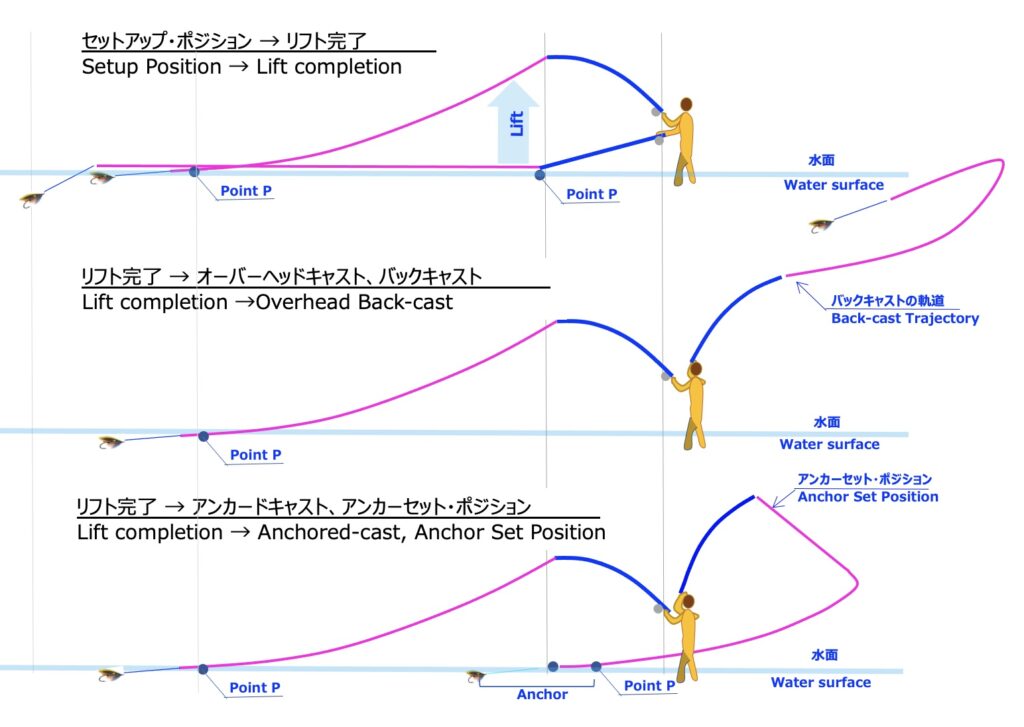
⚫︎ポーズ: Pause
[定義] キャスティングのストロークとストロークの間に取られる間(ま)。
ポーズ中のロッドは静止しているのが基本。一方でポーズ中においては、ローテーション(回転運動)やトランスレーション(並進移動)、またはその両方を組み合わせて行われる動作、ドリフト、ドラグ、フォロースルー、メンド、もその時の目的に応じて行われる。
[Definition] The time period between Casting Strokes.
During a pause, the rod generally remains stationary. However, during the pause, rotation, translation, or a combination of both may be performed, depending on the purpose at the time, such as drift, drag, follow-through, and mend.
⚫︎ドリフト: Drift
[定義] ポーズ中、ループが向かっている方向にロッドティップを移動させる動き。
ドリフトの役目: ドリフトには前後移動、上下移動、両方の組み合わせ、がある。その目的は、
1. ラインが長くなるほどキャスティング・アークを広げる必要がある。 その時にドリフトでアークを広げることになる。
2. ロッドのバイブレーションを吸収してスラックのないループを作る。
3. フォワードキャストの終了と同時にロッドティップを低い位置にドリフトダウン(降ろす)ことで、バックキャストのスタート位置を低いポイントから始め、バックキャストの軌道を高くする。
4. ループがロッドに当たらないように、アークを広げてループの通り道を作るため。
[Definition] Moving the rod tip in the direction of the current cast during the Pause.
The Role of Drift: Drift involves forward-backward movement, up-down movement, or a combination of both. The purposes are:
- The longer the line, the wider the casting arc needs to be. At that time, the drift will widen the arc.
- To absorb rod vibrations and create a slackless loop.
- By drifting down upon finishing the forward cast, positioning the position of the start of back cast allows for a high trajectory backcast.
- To widen the arc and create a clear path so the loop does not hit the rod.
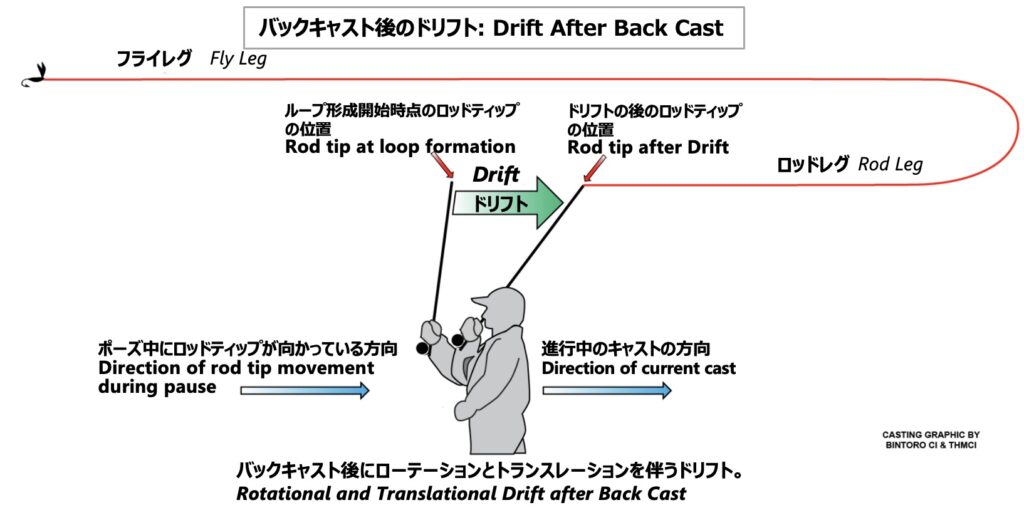
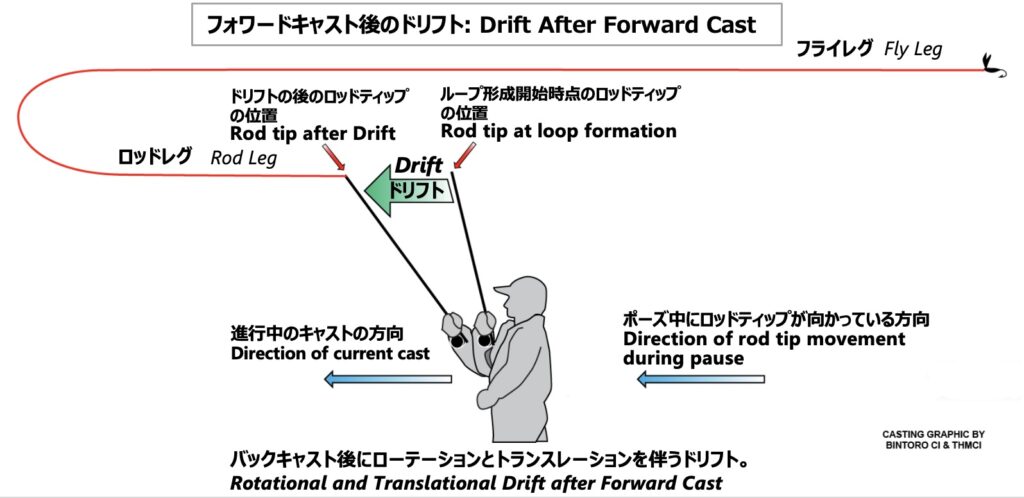
⚫︎ドラグ: Drag
[定義] ポーズ中、次のキャスト方向にロッドティップを移動させる動き。
ドラグの役目: コンスタント・テンションはキャスティングのキーであるが、ドラグはテンションを保つ役目を担う。
- 1. 野球のピッチャー投球と同じく、キャスティングも下半身の捻りから始まり、リストの振りに終わる。ストロークの出だしの部分でロッド、ロッドハンド、前腕はほぼ角度を変えずに下半身の捻り(ローテーション)によって引っ張られるように平行移動で前進し、この時にロッドのローディングが始まる。この並進移動がドラグである。
- 2. 長いラインをキャストするためにキャスティングアークを大きくとっても、ナローループの形成を求める場合、またはアンダースラングループをキャストしたい場合に使われる上級者のテクニック。ストロークに入る前にドラグを使ってストロークへの進入角度調整をすることによって、ロッドのバット部でなく、ロッドの中間部から先端部をよりベンドさせることによって、上記の目的が達成される。
- 3. アンカードキャスティングにおいてドラグとは、Dループスイープによってループが後方に移動する途中の段階でロッドの進行方向は、サークルアップに移る、つまり次のキャスト方向に向かい始める、と言うアンカードキャスティングの基本動作を意味する。
- [Definition] Moving the rod tip in the direction of the next cast during the Pause.
The Role of Drift: Consistent tension is key for casting and the drag helps maintain that tension.
- Same as a baseball pitcher’s motion, casting also begins with a lower body rotation and ends with the arm movement. At the start of the stroke, the rod, rod hand, and forearm move forward without changing their relative angles, dragged by the rotational motion of the lower body. This translational motion is called the Drag, which initiates the loading of the rod.
- An advanced technique involves using drag to cast a long line with a wide casting arc while still aiming to form narrow loops—or to form Underslung Loops. Before entering the stroke, the caster uses drag to adjust the stroke entry angle. This movement causes the rod to bend more in the mid to tip section rather than the butt, thereby achieving the desired loop shape and line control.
- In anchored casting, “drag” refers to the fundamental motion of anchored casting, where during the process of the loop moving backward by the D-loop sweep, the direction of the rod transitions into the circle-up phase — that is, it starts to turn toward the direction of the next cast.
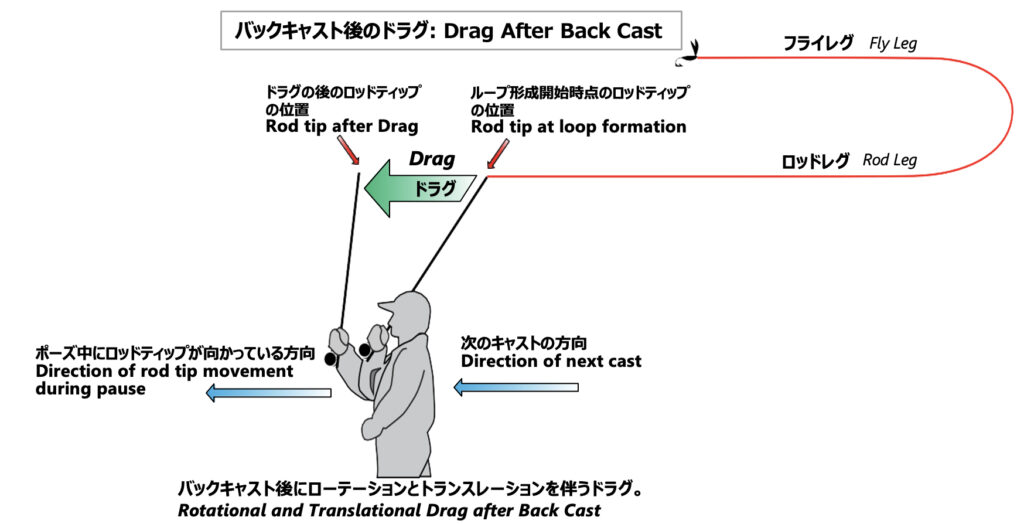
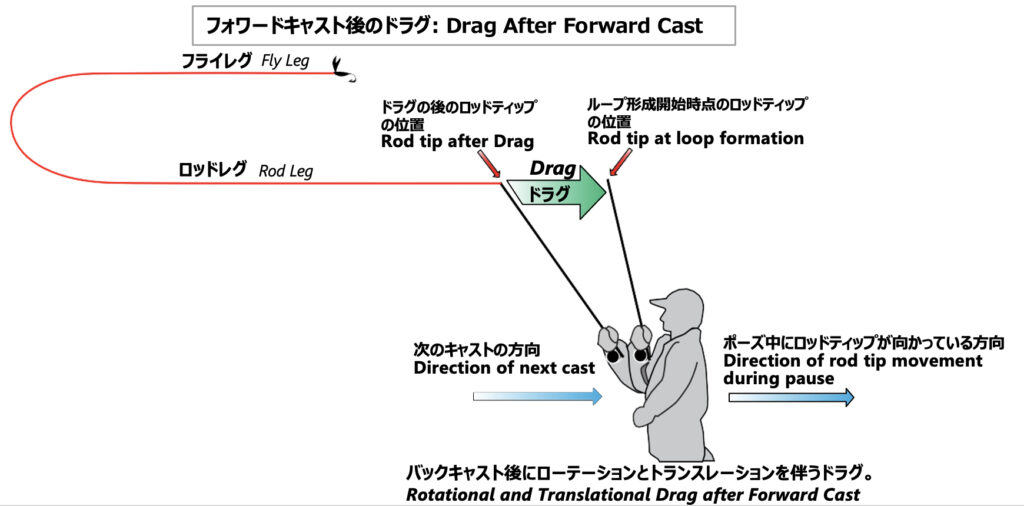
⚫︎フォロースルー: Follow-Through
[定義] デリバリーキャスト後にロッドを前方下向きに動かす動作。
デリバリーキャストでラインをシュートした後にロッドティップを水面近くまでフォローさせることで、着水後直ちにゲームに入る体制を作ること。 ドリフトとしての役目もある。
[Definition] Moving the rod forward and down after the Delivery Cast.
Following through with the rod tip to just above the water after a delivery cast sets you up to get straight into the action the moment your fly hits the surface. It also functions as a drift.
⚫︎アップ/ダウン: Up/Down
[定義] ポーズ中にロッドティップを上下に移動させる動作。
[Definition] Moving the rod tip up or down during the Pause.
⚫︎イン/アウト: In/Out
[定義] ポーズ中にロッドティップを内側(横方向にキャスターに近づく)または外側(横方向に遠ざかる)に移動させる動作。
[Definition] Moving the rod tip in (closer to the caster laterally) or out (further away) during the Pause.
一般的なキャスティングのミス: Common Casting Faults
コンべックス・フライレグのワイドループ: Wide Loop with Convex Fly Leg
[定義] フライレグがドーム状の形状で、ロッドレグも緩んでいるワイドループ。
リストの過剰なローテーションにより、ロッドティップ・パスが、凹状の軌道を辿っているのが原因で、ライン、リーダーの不完全なターンオーバ他、ラインの推進力も減衰する。
[Definition] A wide loop with a dome-shaped fly leg and loose rod leg.
Overuse of wrist rotation causes the rod tip path to follow a concave trajectory, which leads to incomplete turnover of the line and leader, and also reduces the propulsion.
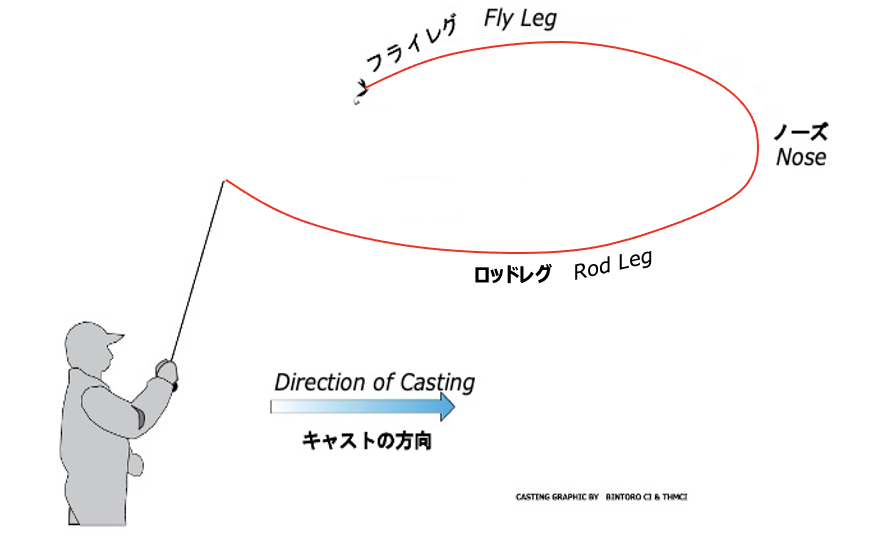
テイリング・ループ:Tailing Loop
[定義] フライレグがコンケーブ(凹型)形状のループで、フライレグがロッドレグに向かって凹んでいることで、ラインが交差している状態のループ。ラインの推進力の低下、不完全なターンオーバー、リーダーの絡まり等の原因となる。
テイリング・ループは、ロッドティップの軌道が凹状である場合に発生する。具体的には、キャスティング・ストローク中の急激な力の掛け方であった時、キャスティング・アークが出されているラインの長さに対して狭すぎる場合、クリープが誘発する場合、ホールをかけるタイミングは悪い場合。
[Definition] A fly leg forms a concave-shaped loop, curving inward toward the rod leg, creating a situation where the line crosses. This reduces the line’s propulsion, leading to an incomplete turnover and causing issues such as leader tangling.
A tailing loop occurs with one priciple, which is the rod tip path is concave. Specifically, abrupt application of force during the casting stroke, casting arc being too narrow for the length of line being cast, creep, and poor timing of the haul.
トラッキング・エラー: Tracking Error
[定義] ストロークの出だしの時のロッドプレーンが、元のプレーンから外れてストップされる時には水平方向にずれているキャスティングのミス。ラインとリーダーの先端が目標から外れて湾曲してしまうことになる。
トラッキング・エラーは、入門者のほぼ全員が経験するエラー。また、ツーハンドロッド・ユーザーの場合、デリバリーキャストは垂直プレーンでキャストしない人が多く、この時にボトムハンドのストロークが半水平方向の円軌道で動かすと、これが無意識のうちにトラッキング・エラーに繋がっている場合が多い。
[Definition] A fault in which the casting rod plane at the start of the stroke deviates from its original plane and shifts horizontally during the casting stroke, causing the line and leader to land in a curved.
Tracking error is an error that almost all beginners experience. In addition, many two-handed rod users do not cast in a vertical plane when on delivery cast, and when they move the stroke of the bottom hand in a semi-horizontal circular orbit, this often unconsciously leads to tracking error.
⚫︎クリープ:Creep
[定義] キャスティングの失敗につながるドラグ。
クリープとは、ポーズ中に次にキャストが向かう方向にロッドティップを無意識に移動させてしまう動き。これによりキャスティング・アーク(回転角)が狭まり、推進力ロスを生む他、テイリングを誘発する場合がある。
[Definition] Drag which contributes to a casting fault.
Creep is the movement of unconsciously moving the rod tip in the direction of the next cast during a pause, narrowing the casting arc, causing a loss of propulsion, and can triggers tailing loop.
ティッキング: Ticking
[定義] フォルスキャスト中にフライ、リーダー、ラインの一部が、水面または地面にヒットしてしまうミス。
[Definition] A fault during a false-cast the fly, leader, or part of the line hits the water surface or ground.
ラストキャスト症候群: Last Cast Syndrome
[定義] プレゼンテーションで失敗した時の記憶がトラウマになって、ラインが水面を叩いたり、シュートする時に足元のライントラブルを繰り返してしまうこと。
ライズやテーリングする魚を前に、チャンスを台無しにするキャストの失敗癖。フォルスキャストと、プレゼンテーションのループ軌道は異なる。ラインの絡みを避けるラインマネージメント。これらを日頃意識しておくことが大事。
[Definition] Memories of failed presentations become traumatic, leading to repeated problems such as the line hitting the water surface or line troubles at your feet when you’re about to shoot.
That all-too-familiar habit of ruining your chance with a poor cast just as a fish is rising or tailing. The loop trajectory of a false cast differs from that of a presentation cast. Line management to avoid tangles. Being mindful of these things on a daily basis is essential.
キャスティングの基本原理: Basic Fly Casting Mechanics
フライキャスティングにおける5つの必須項目: The Five Essentials of Fly Casting
[日本語] “フライキャスティングの必須項目”は、ビル・ガメルが1993年に父親のジェイと連名でその考え方を公開したキャスティングの必須原理。その後もこの考え方を洗練させていき、 現在は”フライキャスティングの5つの必須項目: The Five Essentials of Fly Casting” と言う表現に行き着いている。 その根幹にあるのがビル・ガメルの言う 「キャストによってタイトで真っ直ぐなループを生むためには、ひとつの最も重要な要件、つまり、”キャスティング・ストローク中、ロッドティップは “SLP (Straight Line Path): 直線に近い軌道 を移動しなくてはならない” と言うこと。そしてロッドティップが直線を移動するためには…、以下の5 つの必須項目が連携しあって整っている必要がある」 と言う考え方となる。 (以下、「“Gammel’s Five Essentials of Flycasting Revisited” Bruce Richards氏より引用)
1.最も効率的で空気抵抗の少ないループを形成し、キャストのエネルギーを特定のターゲットに向けるためには、ロッドの先端を直線的に動かさなければならない。この要点は、他の4つの要点が正しく実行された結果として生じるものである。
2.キャスティングアーク(投げる際のロッドの角度の範囲)の大きさは、ロッドの先端から出ているラインの長さに応じて変えなければならない。
3.キャスティングストロークの中で、パワーは適切な量を、適切な場所に適用されなければならない。
4.スラックの入ったラインは、可能な限り最小限に抑えなければならない。
5.各キャスティングストロークとストローク間には必ずポーズ(間=ま)があり、そのポーズの長さはロッドティップから出ているラインの長さによって異なる。
[English] “The Fly Casting Essentials” is a set of essential principles of casting that Bill Gammel published jointly with his father, Jay, in 1993. Since then, Bill has continued to refine this idea, and have now arrived at the expression “The Five Essentials of Fly Casting”. At the core of this idea is what Bill Gammel said (Quoted from Bruce Richards “Gammel’s Five Essentials of Flycasting Revisited”):
“There is one overriding result that must occur for a tight, straight loop to result from the cast. The rod tip must travel as close as possible to a straight line during the casting stroke… In order for a rod tip to travel in a straight line …, there are five things that must occur. “
1.In order to form the most efficient, least air resistant loops, and to direct the energy of the cast to a specific target, the caster must move the rod tip in a straight line. This essential is actually what results when the other 4 essentials are done properly.
2.The size of the casting arc must vary with the length of line past the rod tip.
3. Power must be applied in the proper amount at the proper place in the stroke.
4. Slack line should be kept to an absolute minimum.
5. There must be a Pause between each (casting) stroke, which varies in duration with the amount of line outside the rod tip.
ストレート・ライン・パス (SLP): Straight Line Path
“フライキャスティングにおける5つの必須項目 (The Five Essentials of Fly Casting)”の項を参照。
Refer to the section “The Five Essentials of Fly Casting.”
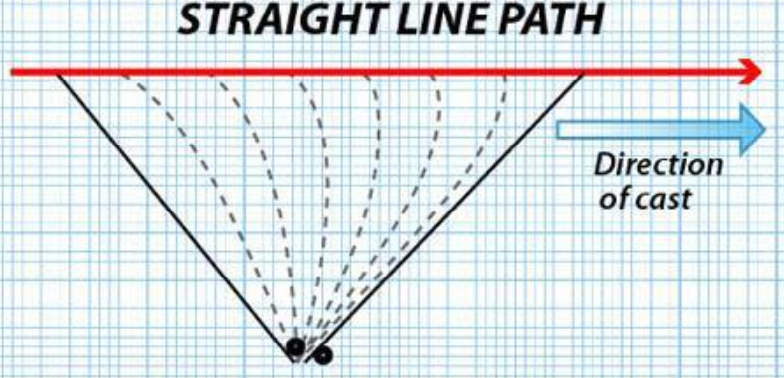
⚫︎180度の原則、オーバーヘッド・キャストの場合:180 Degree Principle (Aerialized Casts)
[定義] 各キャスティングストロークの開始時に、意図したロッドティップの軌道とフライラインの向きが、ターゲットに対して横方向と縦方向共にほぼ直線上に整列されていること。
2025年より「オーバーヘッド・キャストにおける180度の原則の順守」は、「インプレーンループ」というより正しい意味合いを包含する表現に置き換えられた。これは、180度の原則の順守が重要でないという意味ではないので、本稿ではこの言葉を敢えて残しています。
アンカードキャスト(anchored casts)においては、横方向(lateral)の180度の順守は維持されています。
[Definition] The intended Rod Tip Path and fly line are closely aligned both laterally and vertically with the target at the start of each Casting Stroke.
From 2025, the term ‘180 Degree Principle (Aerialized Casts)’ has been replaced with the more accurate expression ‘In-plane loops.’ However, this does not imply that adherence to the 180-degree principle is unimportant, and therefore this Casting Glossary intentionally retains the original terminology.
⚫︎180度の原則、アンカード・キャストの場合:180 Degree Principle (Anchored Casts)
[定義] デリバリーキャストの方向、D-ループ、アンカーがターゲットに対してほぼ直線状に整列されていること。
[Definition] The Delivery Cast, D Loop and the Anchor are closely aligned laterally with the target.
⚫︎速さ、スピード:Speed
[定義] 物体がどれほど速く動いているかを示す量。
スピードの定義=速さの大きさのみを持つスカラー量。 例:「時速60km」となる(速さの大きさのみ)
[Definition] How fast an object is moving.
Definition of Speed = A scalar quantity that has only the magnitude of how fast something moves.
Example: “40 miles/h,” which expresses only the magnitude of the speed.
⚫︎速度:Velocity
[定義] 物体のスピードに、その運動の方向を加えたもの。
ループは一旦形成されると、推進力とラインのスピードはフライレグが支配するようになり、最後にループが完全にターンオーバーすると急激に推進力とスピードを失い水面に落下し、実質的に“速度ゼロ”の状態になる。
速度の定義=方向と速さの両方を持つベクトル量
例:「東向きに時速60km」となる(方向と速さの両方)
[Definition] Speed in combination with the direction of motion of an object.
Once a loop is formed, the propulsion and line speed become dominated by the fly leg. When the loop finally completes its turnover, it rapidly loses both propulsion and speed, drops onto the water, and effectively reaches a state of ‘zero velocity.
Definition of Velocity = A vector quantity that has both direction and speed.
Example: “40 miles/h to the east,” which includes both the direction and the speed.
⚫︎等速度:Constant Velocity
[定義] 加速ゼロの速度。
[Definition] Acceleration is zero.
慣性: Inertia
[定義] 物体が現在の運動状態(静止または等速直線運動)を続けようとする性質。
ストローク中にSLP(ストレートライン・パス)を辿りながらフライラインを引っ張り続けて来たロッドティップが急激にストップすることで、ライン自体はその運動状態を保ち続けようとしてループを形成し前進を続ける、その原動力が「慣性」と言うことになる。この意味で慣性力は、フライキャスティングを成立させる源と言える。
[Definition] The property of an object to continue its current state of motion (either at rest or in uniform straight-line motion).
During the stroke, the rod tip that has been pulling the fly line along the SLP (Straight Line Path) comes to an abrupt stop. As a result, the line itself tries to maintain its state of motion, forming a loop and continuing to move forward. This driving force is called “inertia.” In this sense, the inertial force can be regarded as the fundamental source that makes fly casting possible.
⚫︎加速: Acceleration
[定義] 時間とともに速度が変化する割合のこと。これは正にも負にも、またはゼロにもなりうる。
ストローク開始時から、終了点=ロッドティップの移動が完全にストップするポイント、に至るまで、徐々にロッドティップの移動スピードを上げていくこと。 「スムーズな加速」は「パワースナップ」と並んで空気力学的に最適なループ形状を作る上で加速を語る時に要となる。変則的な力を加えてしまうと、フライレグに凹みやスラックが入る不効率なループ形状にもたらす原因となる。
[Definition] The rate at which velocity changes over time. It may be positive, negative or zero.
Gradually increase the speed of the rod tip movement from the start of the stroke until the endpoint, where the rod tip’s movement comes to a complete stop.”Smooth Acceleration” along with “Power-snap” is a key factor when discussing acceleration in creating an aerodynamically optimal loop shape. Applying irregular forces can cause dents and slack in the fly leg, resulting in an inefficient loop shape.
⚫︎正の加速:Positive Acceleration
[定義] 物体が設定した進行方向に対して速度を増加させている状態を指す。
[Definition] Speed in combination with the direction of motion of an object.
⚫︎負の加速度、減速:Negative Acceleration or Deceleration
[定義] 物体の速度が減少すること。
ストロークの中でロッドバット部は、MRP (マキシマム・ロッドベンド・ポジション)まで加速したあとローテーションのフェーズに入ると減速することになる。一方でロッドティップは、ストロークの開始時点から、終了点=ロッドティップの移動が完全にストップするポイントまで、加速しながらスピードを増して行く。
[Definition] A decrease in the velocity of an object.
During the stroke, the rod butt section accelerates until it reaches the MRP (Maximum Rod Bend Position), then decelerates as it enters rotation phase.On the other hand, the rod tip continues to accelerate and increase its speed from the very beginning of the stroke until the end point — the moment when the rod tip’s movement comes to a complete stop.
ベクトル: Vector
[定義] ベクトルとは、「大きさ(長さ)」と「向き(方向)」の両方をもつ量のこと。 例えば、風の「速さ」と「吹く方向」を表すときに使われる。
[Definition] A vector is a quantity that has both magnitude and direction. For example, it can represent wind speed and direction.
⚫︎フォース:Force
[定義] 物体に加えられる押す力または引く力。
キャスティング ストロークの中でPower と Force は同じ意味で使われる。 パワーと言う表現は一般的であるが、FFI ではより意味合いとして正しい言葉である「フォース」の使用を推奨している。
[Definition] A push or a pull on an object.
In casting strokes, Power and Force are interpreted interchangeably. Although Power is a common term, FFI recommends the use of Force, as it is the more correct word.
推進力:Propulsive Force
[定義] 物体を前へ動かすために働く力、または前方への運動を生み出す力。
[Definition] A force that moves an object forward, or generates forward motion.
ポイント推進力 / 分散推進力: Pointed Force / Distributed Force
[定義] 同じ量の推進力でも、これが一点に集中している場合と広範囲に分散している場合とでは、異なる結果になる。その違いを言い表すのが、ポイント推進力 / 分散推進力、となる。
ポイント推進力 (ポインテッド・フォース) : ピンポイントに作用する荷重。
分散推進力 (ディストリビューテッド・フォース): 広い範囲にわたって作用する荷重。
ループに置き換えるとポイント推進力 (ポインテッド・フォース)の高い形状は、ナローループ、分散推進力 (ディストリビューテッド・フォース)の高い形状は、ワイドループ、と言うことになる。ラインの質量、ロッドティップの移動スピード、方向が同じでラインをシュートする前提に立つと、推進力が一点に集中して作用するポイント推進力の高いループの方が、より遠くに、また空気抵抗が少ない分、シュート後のラインスピードは早くなる。
[Definition] Even when the same amount of propulsive force is applied, the result differs depending on whether the force is concentrated at a single point or distributed over a wide area. This difference is expressed as pointed (propulsion) force and distributed (propulsion) force.
Pointed Force: A load acting at a single point.
Distributed Force: A load acting over a wide area.
When applied to a loop, a shape with a high pointed force corresponds to a narrow loop, while a shape with a high distributed force corresponds to a wide loop. Assuming that the line’s mass, the rod tip’s movement speed, and its direction are the same, a loop with a higher pointed (propulsive) force—where the propulsive power is concentrated at a single point—will travel farther. In addition, due to reduced air resistance, the line speed after the shoot will be faster.
⚫︎パワー:Power
[定義] 仕事が行われる速度、またはエネルギーが移動する速度を示す量で、単位時間あたりに行われた仕事として求められる。
[Definition] A measure of the rate at which work is done, or at which energy is transferred, computed as work done per unit of time.
⚫︎トルク:Torque
[定義] 物体の回転軸まわりの回転を変化させる力。
[Definition] A force that can cause an object to change its rotation about an axis.
⚫︎質量:Mass
[定義] 物体を構成している物質や材料の量。
[Definition] The amount of matter or substance that makes up an object.
⚫︎重量:Weight
[定義] 重力が質量に作用した結果として生じる力。
[Definition] The result of the force of gravity acting on a mass.
⚫︎仕事量:Work
[定義] 物体に加えられる、または物体から得られるエネルギー。仕事量 = “力” X “その力が作用した距離”
[Definition] The energy transferred to or from an object, computed as force multiplied by the distance over which it is applied.
⚫︎エネルギー:Energy
[定義] 物体が仕事を行うことのできる能力。エネルギーには次のような形態がある:
・位置エネルギー(蓄えられたエネルギー)
・運動エネルギー(働いているエネルギー):物体の質量の半分に、その速度の二乗を掛けて求められる。
[Definition] The capacity of an object to do work. Forms of energy include:
・Potential or stored energy
・Kinetic or working energy, computed as half an object’s mass multiplied by the square of its velocity.
⚫︎運動量:Momentum
[定義] 物体の運動量は、その質量に速度を掛けたものとなる。
[Definition] An object’s momentum is its mass multiplied by its velocity.
⚫︎力積:Impulse
[定義] 物体に与えられる、または物体から伝わる運動量のことで、作用した力にその力が加わっていた時間を掛けて求められる。
[Definition] The momentum transferred to or from an object, computed as force multiplied by the time over which it is applied.
⚫︎ニュートンの運動の法則:Newton’s Laws of Motion
[定義]
・第1法則(慣性の法則):物体は、外から合力が加わらない限り、現在の運動状態(静止または等速直線運動)を保ち続ける。
・第2法則(力の法則):物体の加速度は、その物体に作用する合力に比例する。
力は「質量 × 加速度」で表される。
・第3法則(作用・反作用の法則):すべての作用には、大きさが等しく反対向きの反作用が存在する。
[Definition]
・First Law of Motion: Inertia – An object will continue its current motion or lack thereof until some net force causes its speed or direction of movement to change.
・Second Law of Motion: Force – The acceleration of an object is directly proportional to the net force acting on it. Expressed as force equals mass times acceleration.
・Third Law of Motion: Action/Reaction – For every action, there is an equal and opposite reaction.
プレゼンテーション: Presentations
プレゼンテーション: Presentations
[定義] 狙ったスポットにフライとリーダーとフライラインを意図したアレンジメント(配置、スピード)で届ける行為。
[Definition] The act of delivering the fly, leader, and fly line to the targeted spot with the intended arrangement (placement and speed).
⚫︎ストレートライン・プレゼンテーション: Straight Line Presentations
[定義] 水面に落とすラインを直線状に配置するキャスティング・ストローク、ないしメンディング。
[Definition] Casting Strokes and/or Mends which produce a straight fly line layout.
⚫︎スラックライン・プレゼンテーション: Slack Line Presentations
[定義] 水面に落とすラインにスラックを入れるキャスティング・ストローク、ないしメンディング。
[Definition] Casting Strokes and/or Mends which produce slack line layouts.
⚫︎カーブド・プレゼンテーション: Curved Presentations
[定義] 水面に落とすラインを曲線状に配置するキャスティング・ストローク、ないしメンディング。
[Definition] Casting Strokes and/or Mends which produce a curved line layout.
スラックライン・プレゼンテーション: Slack Line Presentations
[定義] 水面に落とすラインにスラックを入れるキャスティング・ストローク、ないしメンディング。
デリバリーキャストでストップの前にロッドを操作してスラックラインを作る場合をキャスト(例: パイルキャスト、タックキャスト)、ストップの後にロッドを操作してスラックラインを作る場合をメンド(例: リーチメンド、ウィッグルメンド)と言う。
[Definition] Casting Strokes and/or Mends which produce intentional slack line layouts.
In a presentation cast, If you create slack line by moving the rod before the stop in a delivery cast, it’s called a cast—like a pile or tuck cast. If you do it after the stop, it’s called a mend—like a reach or wiggle mend.
⚫︎メンド/メンディング: Mends
[定義] デリバリーキャストでのロッドストップの後に、フライラインの配置を修正するためのロッドの操作。
oエリアル・メンド:フライラインとリーダーが着水する前に行うメンディング。
oウォーター・メンド:フライラインとリーダーが着水した後に行う メンディング。
メンディングは、フライが水中をスイングするスピードの調整、及びフライが泳ぐ泳層(ウォーターコラム)をコントロールする場合で使う場合、または、ドラグフリーでフライを流したい場合に使用される。
[Definition] Manipulating the fly line layout by rod movement after the Stop on a Delivery Cast.
o Aerial Mends – mending before the fly line/leader lands on the water.
o Water Mends – mending after the fly line/leader lands on the water.
Mending is used to adjust the speed at which the fly swings underwater and to control the depth (water column) at which the fly swims, or when you want to drift the fly drag-free.
リーチメンド: Reach Mend
[定義] リーチメンドは、ドラグフリーでフライをドリフトするために、デリバリーキャストでストップのあと、ロッドを大きく上流側に倒して(エリアルメンド)、ターゲットポイントに対してフライラインとリーダーに角度をつけてプレゼンテーションすること。
さまざまなメンディング・テクニックの中でもリーチメンドが特に優れている点は、突出したアキュラシー性。ナローループで、ターゲットの少し上空に向けたトラジェクトリー(射出角)でデリバリーさせることで、あとはラインをスリッピングさせ軽くシューティングの要領で伸ばしてやることで、正確なプレゼンテーションが可能。また、リーチメンドにカーブキャストやスラックラインをミックスしてキャストすることも可能。
[Definition] Reach mend is a technique used to achieve a drag-free drift by making an aerial mend after stopping the delivery cast, tilting the rod significantly upstream, and presenting the fly line and leader at an angle to the target point.
Among the various mending techniques, reach mend stands out for its exceptional accuracy. By delivering with a narrow loop and a trajectory aimed slightly above the target, and then letting the line slip out with a light shooting motion, you can achieve a highly precise presentation. It is also possible to mix Reach Mend with a Curved and/or a Slack-line presentation.
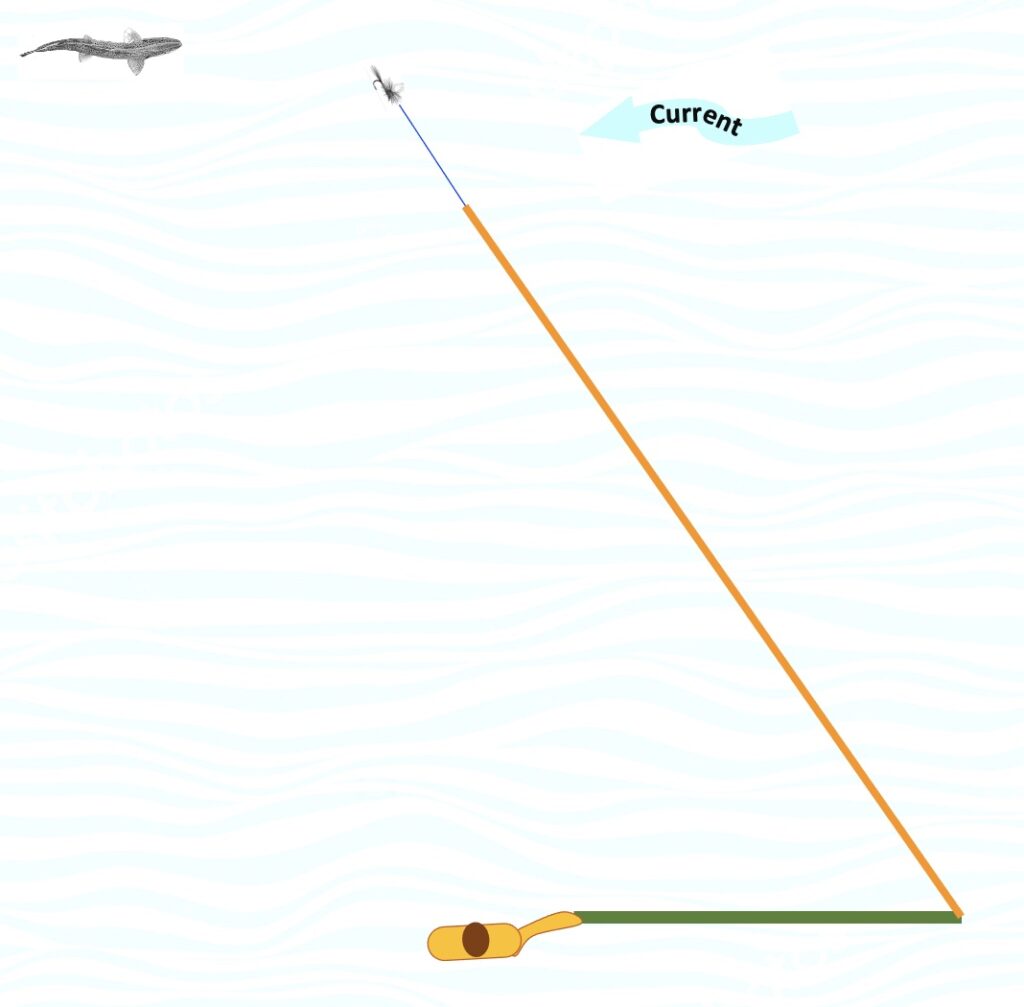
ウィグルメンド: Wiggle Mends
[定義] デリバリーキャストでロッドをストップさせた後に、ロッドティップを、ロッドの垂直下降経路の左右に下向きの「ジグザグ」パターンで操作し、ループのロッドレグに連動した対称的な横向きのスラックを形成する方法。
フライとフライラインのプレゼンテーション後に、ドラグフリーでフライが流せるように意図的にスラックを作るスラックドライン・プレゼンテーションの一つ。
[Definition] After stopping the rod in the delivery cast, manipulate the rod tip in a downward ‘zigzag’ pattern to the left and right of the rod’s vertical drop path, creating a symmetrical lateral slack that corresponds to the rod leg of the loop.
One type of slack-line presentation, where intentional slack is created after the presentation of the fly and fly line to allow the fly to drift drag-free.
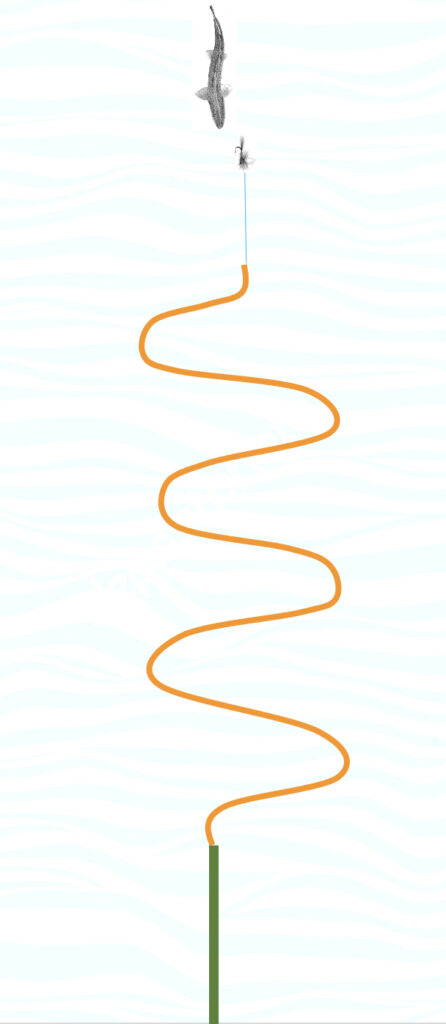
パイルキャスト: Pile Cast
[定義] 低いバックキャストを行い、続いて斜め上空に向けてデリバリーキャストを行う。この上向きのストロークで、ラインがターンオーバーした直後にラインの落下にシンクロさせてロッドティップを水面に降ろす。この動作で、スラックライン・プレゼンテーションが成立する。
パイルキャストは、デリバリーキャストの上空に向けた射出角度で、ライン全体にスラックをかけるための「高角度キャスト」、リーダーだけにスラックをかけるための「低角度キャスト」、の使い分けがし易いと言うメリットがある。
[Definition] Make a low back cast, followed by a delivery cast angled upward. As the line turns over during this upward stroke, lower the rod tip to the water surface in sync with the falling line. This motion completes the slack-line presentation.
Pile cast has the advantage of allowing flexibility in applying slack—either applies slacks to the entire line by high-angle cast or only to the leader by low–angle cast.
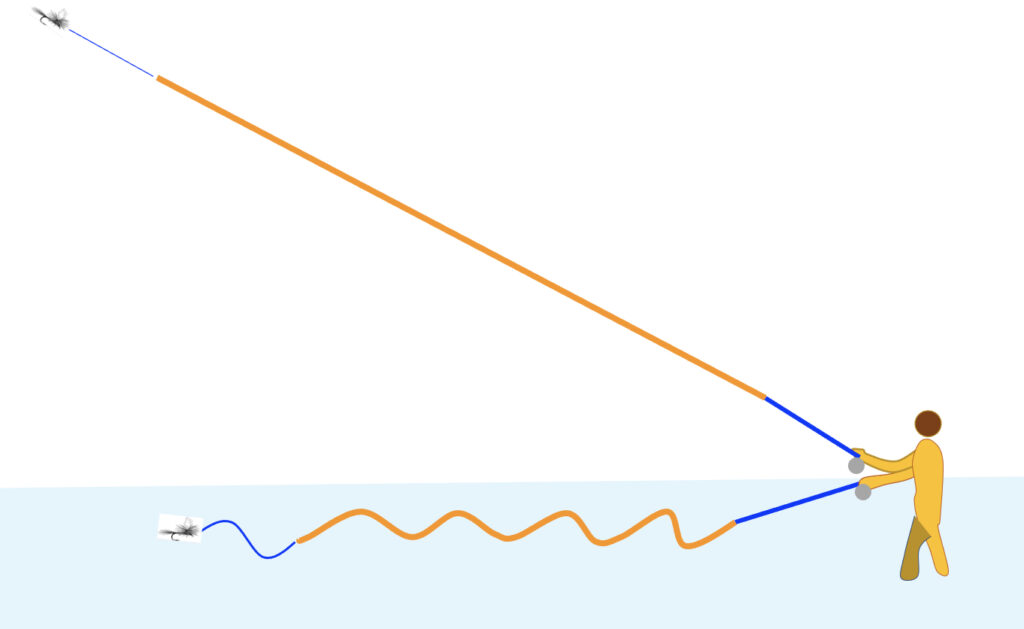
タックキャスト: Tuck Cast
[定義] タックキャストは、オーバーパワーの強引なストップをかけることで、勢いよくターンオーバーさせることでニンフ、ウェットフライを水中にダイブさせ、更に着水したフライの上にリーダーとフライラインが束になって落下させるキャスト。フライは容易に沈降し、束になったリーダーとラインがスラックライン・プレゼンテーションを成立させる。
[Definition] The tack cast is made with an overpowering firm stop, which kicks over the leader, dives the nymph or wet fly into the water, and the ends of the leader and fly line piled up in place. These movements allow the fly to sink easily and drift naturally with the slacks.
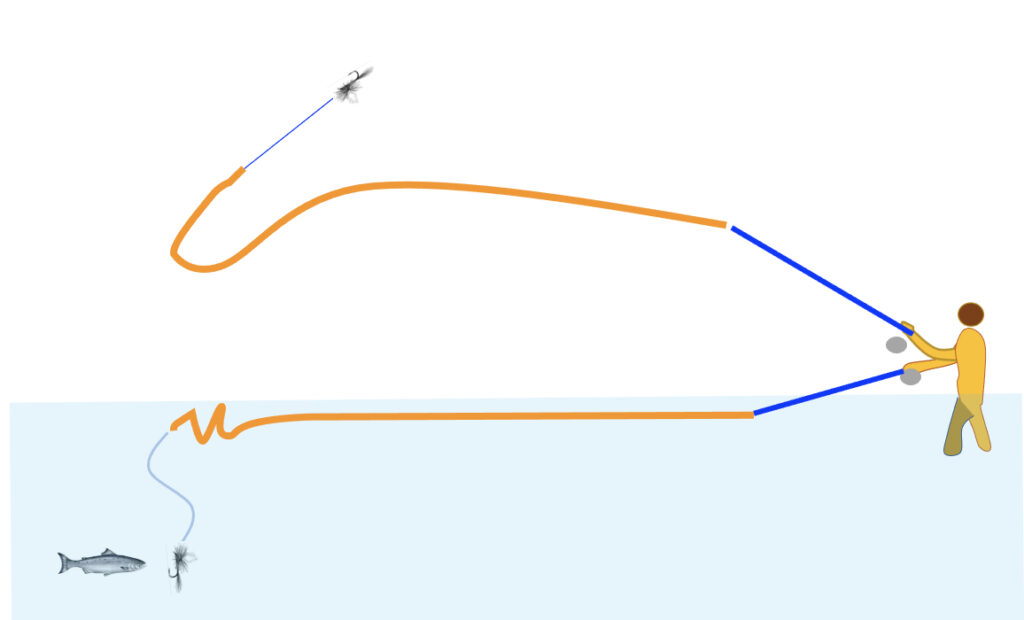
カーブトライン・プレゼンテーション: Curved Line Presentations
[定義] 水面に落とすラインを曲線状に配置するキャスティング・ストローク、ないしメンディング。 (注:FFI公式用語集では、カーブト・プレゼンテーション、と言う表現にしている。)
[Definition] Casting Strokes and/or Mends which produce a curved line layout.
カーブキャスト: Curve Cast
[定義] カーブキャストは、デリバリーキャストでの空中操作で湾曲させたライン配置でプレゼンテーションするキャスト。
水平面、垂直面の両方のプレーンを通してカーブをかけるキャスト法がある。水平面の場合は、水平面のプレーン上でオーバーパワーの強引なリストのクイックローテーション(パワースナップ)をかけることで、勢いよくターンオーバーさせる。タックキャストをサイド・キャストで行う要領。垂直面でカーブをかける時には、 ロッドを垂直面でスタートした後、ストロークの終盤でリストのローテーションをかける時に、カーブをかけたい方向にいきなり意図的にプロネーションをかけてトラッキングを外し、ラインを湾曲させてプレゼンテーションする。垂直面プレーンからのカーブキャストのもう一つの方法として、コラプストキャストもある。
[Definition] A curve cast is a casting technique that presents the fly with a curved line layout achieved through aerial manipulation during the delivery cast. (Note: In the 2024 FFI official Casting Defnitions, the term is expressed as “Curved Presentation.”)
There is a casting technique that applies a curve through both horizontal and vertical casting planes.In the case of the horizontal plane, a forceful turnover is achieved by applying an overpowering wrist snap (power snap) with a quick rotation on the horizontal casting plane.When curving on the vertical plane, after starting the rod stroke within the vertical plane, intentionally applies a sudden pronation at the during the wrist rotation phase at the end of the stroke. This causes the rod tip to deviate from the tracking path, thus creating a curved line presentation.Another method for achieving a curve cast from the vertical plane is the “collapsed cast“.

コラプストキャスト: Collapsed Cast
[定義] カーブトライン・プレゼンテーションのバリエーションの一つ。意図的に推進力不足(アンダーパワー)でターンオーバー仕切らないループをキャストし、カーブ形状のラインをプレゼンテーションするキャスト。ロッドのキャスティング・プレーン(面)がほぼ垂直であることが特色。90°以上のカーブ角度に適する。
右手キャストで右カーブを作る場合は、ほぼ垂直のプレーンでデリバリーキャストを行い、ループは勢いを殺したアンダースラング・ループでキャストする。 ストローク終盤のローテーションで右から左にリストのスーピネーション(回内運動)をかけ、ラインをL字型に落下させる。
[Definition] This cast presents a curved line layout by intentionally casting an underpowered loop that does not fully turn over. A distinctive feature of this technique is that the rod’s casting plane is nearly vertical. It is suitable for curve angles exceeding 90 degrees.
When casting with the right hand to make a right curve, perform a delivery cast on a nearly vertical plane, and cast an underslung loop that will kill the propulsion. At the end of the stroke, rotate wrist (supination) from right to left, and let the line fall in an L shape.
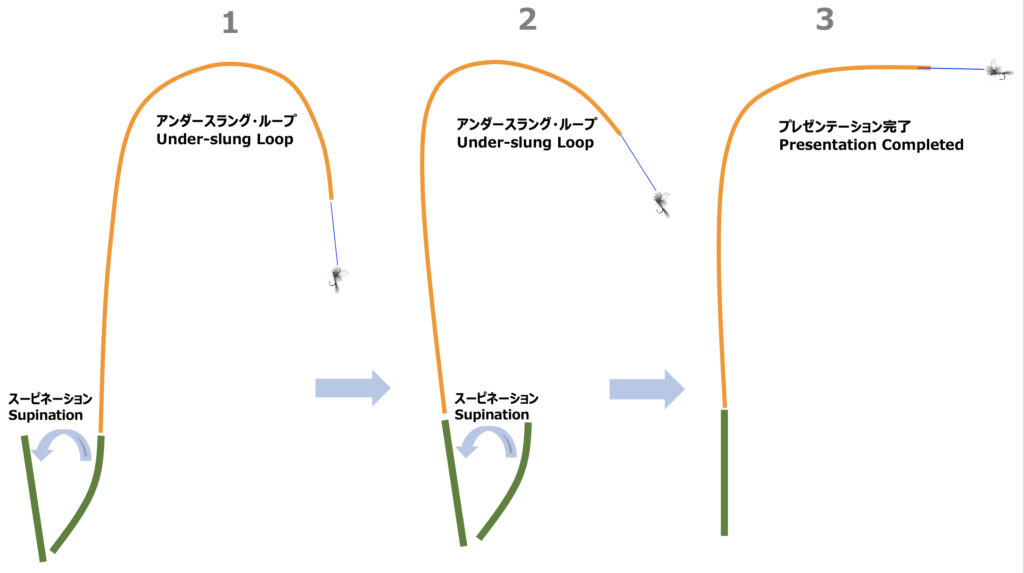
キャスティング・テクニック: Casting Techniques
オーバーヘッド (エリアル)・キャスティング: Overhead (Aerial) Casting
[定義] 最初のリフトからデリバリーキャストを行うまで、フォワードキャストとバックキャストを空中に保ったまま行われるキャスト。
[Definition] After the initial Lift, aerialized forward and back casts are made until the Delivery Cast.
⚫︎フォルスキャスト: False Cast
[定義] フォワードキャストに続くバックキャストの両方において、ラインを空中に保つキャスト。
[Definition] A forward cast followed by a back cast, both of which remain aerialized.
⚫︎ホール/ホーリング: Hauling
[定義]
- シングルホール:フォワードまたはバックキャスト・キャスティング・ストロークの内どちらか一回、ロッドのガイドを通してフライラインを引く動作。
- ダブルホール:一連のキャスティング・ストロークの中で、フォワードキャストとバックキャストの両方で、ポーズ中にラインハンドをロッドハンドまで戻した後にロッドのガイドを通してフライラインを引く動作。
ホール (ホーリング) は、ラインにスピードをつけたい場合、ロングキャストをしたい時、また、ロッドハンドの負荷軽減をすること、を目的に使われれる。
[Definition]
- Single Haul – Pulling the fly line through the rod guides during either the forward or back Casting Stroke.
- Double Haul – Pulling the fly line through the rod guides during consecutive Casting Strokes, after returning the line hand towards the rod hand during the Pause.
Hauling is used to increase line speed, achieve longer distances, and ease the strain on the rod hand.
サイドアーム・キャスト: Sidearm Cast
[定義] 「サイドアーム・キャスト」は、日本で「サイドキャスト」と呼ばれている言葉と同じ意味。キャスティング・プレーンを水面とほぼ平行に通すキャスティング・テクニック。
キャスティング・プレーンが水平面から逸脱しないことがポイントで、これが出来ないとフライとリーダーは、枝の下にフライをプレゼンテーションしたりする、と言う本来のサイドアーム・キャストの目的が果たせなくなる。サイドアーム・キャストは、キャスターのロッドハンドに吹きつけてくる横風に対してもある程度有効である。
[Definition] A casting technique in which the casting plane is almost parallel to the water surface.
The key point is to keep the casting plane from deviating from the horizontal plane. otherwise, the fly and leader will fail to present the fly under branches, thus defeating the primary purpose of the sidearm cast. The sidearm cast is also effective against mild crosswinds blowing toward the caster’s rod hand.
⚫︎オーバル/ゲベーツロイター/ベルジャン/エリプティカル・キャスト: Oval/Gebetsroither/Belgian/Elliptical Cast
[定義] 比較的水平なロッドプレーンでバックキャストし、そこからストップすることなく、垂直に近いロッドプレーンでフォワードキャストに移行していくコンティニュアス・テンションキャスト。
上記の呼び名は、キャスト的には全て同じものを意味する。
[Definition] A Continuous Tension Cast formed by a relatively horizontal back cast Rod Plane which then transitions without stopping into a more vertical Rod Plane on the forward cast.
All of the above casting names refer to the same cast.
バーネガットベイ・キャスト: Barnegat Bay Cast
[定義] 別名バックキャスト・デリバリーキャストとも言われる。通常とは逆にプレゼンテーションする方向を背にしてバックキャストでポイントにフライを落とす手法。
風がロッドハンドに向けて吹く時に使われる。米国ニュージャージー州のバーネガット湾とその防波島は東向きに大西洋に面しており、コンスタントに強い南風が吹くことで知られる。この場所で地元のフライフィッシャーによってこのキャストは生み出された。 バックキャスト・デリバリーと言う言い方もする。
[Definition] Also known as the Back Cast Delivery, this is a technique in which you cast the fly to the point with your back facing the direction of the presentation, the opposite of the usual.
Barnegat Bay, New Jersey and its barrier islands face East into the Atlantic Ocean, and the prevailing usually strong winds are from the South.Right-handed saltwater anglers there are credited with developing and naming the cast.This is also called backcast delivery.
ゴールウェイ・キャスト: Galway Cast
[定義] フォルスキャスト中にターゲットに向かってキャストする場合でも、ターゲットと反対側にキャストする場合でも、バックキャストの姿勢を取らず、ループの飛ぶ方向を向いて、常にフォワードキャストの姿勢でキャストする方法。
アイルランドのゴールウェイは、背後に障害物がある場所が多く、バックを確認しながらキャストするためにこの方法が生み出された。
[Definition] During the false cast whether casting towards the target or opposite side of the target, always cast in a forward casting position, facing the direction of the loop, without taking a backcast position.
Galway in Ireland has many places with obstacles behind it, so this method was developed to allow anglers to cast while watching the back.
バックキャスト・デリバリー: Back Cast Delivery
[定義] ターゲットに対してバックキャストのモーションでフライをプレゼンテーションするキャスト法。
このキャストは、キャスターの利き手側に吹く風に対処するのに有用。 別名バーネガットベイ・キャストとも呼ばれる。
[Definition] This is where an angler turns and delivers a back cast to the target.
This cast helps to counter wind that blows on the caster’s dominant hand side. Also called the Barnegat Bay cast,
ソルトウォーター・クイックキャスト: Saltwater Quick Cast (SWQC)
[定義] スキッフ(フラッツボート)からのキャスティングで、通常2回以内のフォルスキャストで、かつ高速で遊泳するターゲットの魚に気づかれない静かなプレゼンテーションを行うテクニック。
スキッフとは小型船のことで、高速で餌を求めて回遊するターゲットフィッシュを狙うフラッツボートを指す場合が多い。海上では間断なく風が吹いているのが通常だが、この状況の中でキャストの精度と安全を確保し、足元のラインが絡まないラインマネージメント能力、そしてスピードが問われることになる。
[Definition] It is a technique used when casting from a skiff (flats boat) and usually requires no more than two false casts and a quiet presentation against fast moving target fish.
A skiff is a small boat, often refers to a flats boat used to target fast-moving, cruising game fish. Out on the water, the wind is almost always blowing, and in such conditions, safety, casting accuracy, proper line management to prevent tangles at your feet, and speed are all essential.
ブレーシング: Bracing
[定義] ラインを水からリフトして引き上げる時にファイティングバットを前腕に固定して、テコの作用で「バックキャストデリバリー」を行うことで、ターゲットに向かってパワフルなバックキャストを行えるようにする方法。
ほとんどのソルトウォーター用フライロッドにはファイティングバットが付いているが、これによって魚とのファイティング時にロッドハンドで魚の負荷を支えることができる。 これを行う方法を元来ブレーシングと呼ぶ。これをバックキャストに流用するテクニックとして使うようになった。
[Definition] By bracing the fighting butt against the forearm when lifting the line from the water, and using leverage to perform a powerful backcast towards the target.
Most saltwater fly rods come with a fighting butt, which allows the angler to brace the rod with the rod hand during the fight. This method is originally referred to as ‘bracing’.This technique has since been adapted for use in the backcast as well.
ウォーターホール/ウォーターロード: Water Haul/Water Load
[定義] 水面の表面張力を利用してラインに抵抗をかけることで、ロッドを曲げて(ロードして)キャストのエネルギーを生み出すことができる。これにより、余分なフォルスキャストを省いてキャストするテクニックを言う。
[Definition] This technique utilizes the surface tension of the water to create resistance on the line, allowing the rod to bend (load) and generate casting energy. As a result, it enables casting without the need for excessive false casts.
アンカード・キャスティング: Anchored Casting
[定義] バックキャストのループがロッドティップの下を通過し、アンカーとDループを形成するキャストの総称。
アンカード・キャストの括りで方向転換を伴うものをスペイキャストと言う。 よって、方向転換を伴わないロールキャスト、スイッチキャストは、スペイキャストには属さない。
[Definition] A cast whose back cast Loop passes underneath the rod tip and forms an Anchor and a D Loop.
Under the category of anchored casts, those involving a change of direction are referred to as Spey cast. Therefore, Roll cast and Switch cast, which do not involve a change of direction, are not classified as Spey cast.
アンカード・キャスティング一般用語: Anchored Casting General Terms
⚫︎アンカー: Anchor
[定義] Dループの底部で水に接しているフライとリーダー、及びフライラインの部分。
アンカーの役目は主に Dループを形成するための仮留めとしての役割で、適切な長さのアンカーを設置させること、アンカー先端がターゲットに向いていることが効率の良いキャストに繋がる。
[Definition] The fly and fly line/leader in contact with the water at the bottom of the D Loop.
The anchor acts mainly as a temporary hold for forming the D-loop. A properly placed anchor—with the tip pointing toward the target—is key to an efficient cast.
⚫︎Dループ: D Loop
[定義] アンカード・キャストにおけるロッドティップとアンカーの間に形成される丸みをおびた形のバックキャストループ。アンカード・キャストにおける、さまざまな形状のバックキャストループの総称としても使われる。
Dループは 1.ターゲットに対して180度の方向を指しているか、 2.スラックがなくタイトであるか、 3.アンカーの長さが適切であるか、によってキャストが上手くいくかの分けれ道になる。
[Definition] A round shaped back cast Loop between the rod tip and the Anchor of an Anchored Cast. Also used as a generic reference to back cast Loops of any shape in Anchored Casts.
The quality of D loop is determined by 1. whether it is pointing 180 degrees to the target, 2. whether it is tight and without slack, and 3. whether the length of the anchor is appropriate.
⚫︎Vループ: V Loop
[定義] アンカード・キャストにおいて、ロッドティップとアンカーの間に形成されているバックキャストループがV字状に尖っているもの。
Vループはタイトで狭いループを作るのに効果的であるが、遠投をするための必須条件ではない。但し、使用するヘッドが長ければ長いほど、意図せずともバックループはより尖った形状になる。
[Definition] A pointed back cast Loop between the rod tip and the Anchor of an Anchored Cast.
While the V loop is effective for forming tight and narrow loops, it is not a necessary condition for long-distance casting.The longer the head you use, the more pointed the back loop will inevitably be.
⚫︎アンカー・ポジション: Anchor Position
[定義] キャスターの立ち位置から見たアンカーの位置、及びそのレイアウト。
標準的なアンカーポジションは、ターゲットに対してスクエアにスタンスを構える時に、コネクション・ポイントは45°斜め前、ロッド一本分離れた地点。 ポイント-Pは、90度ラインよりもターゲット寄り。
[Definition] The location and layout of the Anchor relative to the caster.
The standard anchor position is when you are square to the target and your connection point is 45 degrees forward, one rod length away. Point-P is closer to the target than the 90 degree line.
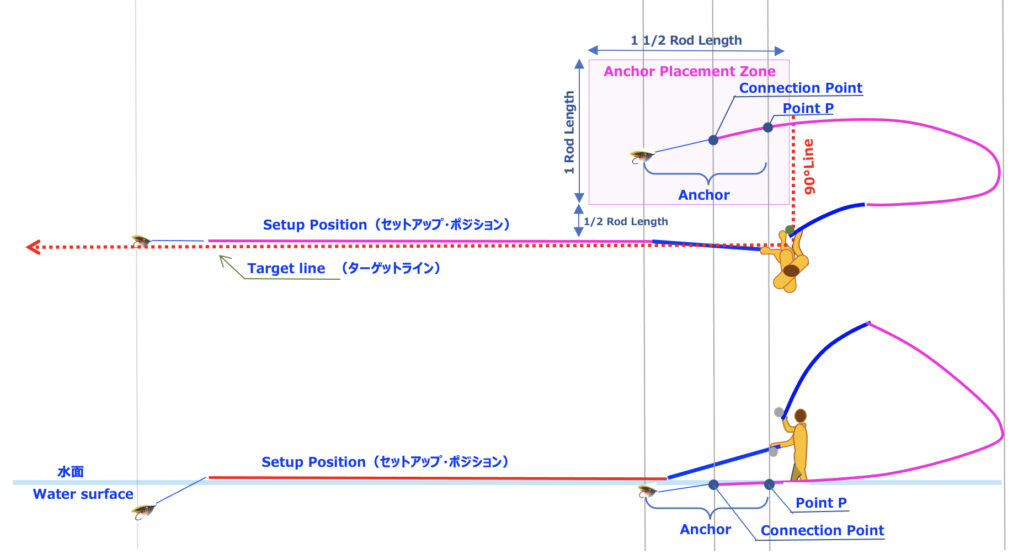
アンカー設置ゾーン: Anchor Placement Zone
[定義] アンカードキャストの際、トラブルなく効率のよいキャストに結びつけることのできるアンカー配置の領域。
バックスペースが十分にない場合は、アンカーはターゲット寄りに設置し、Dループの後方への奥行きを小さくする。この場合、図で示す延長アンカー設置ゾーンまでアンカーが前進して設置される。
[Definition] The anchor placement zone that leads to an efficient cast during an unanchored cast, without causing any trouble.
If there is insufficient backspace, the anchor should be installed closer to the target, and the depth of the D loop towards the rear should be reduced. In this case, the anchor will be advanced and installed up to the Extended Anchor Placement Zone indicated in the diagram.
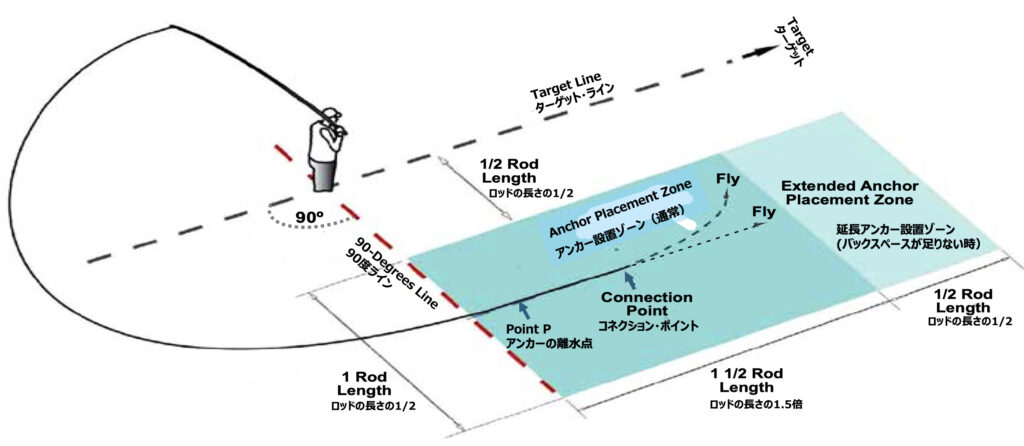
⚫︎ポイントP: Point P
[定義] フライラインが、ロッドティップから垂れ下がり最初に水に触れるポイント。
ポイントPは、ラインが真っ直ぐな状態からロッドをリフトするに従ってキャスターから遠のく(下記図左) 。 Dループを作った後の平均的に理想的なポイント-Pの位置は、90度ラインより少しターゲット寄り(下記図右)。
[Definition] The point where the fly line suspended from the rod tip first touches the water.
Point P moves away from the caster as the rod is lifted from a straight line position (left diagram below). On average, a good Point P position is slightly beyond the target from the 90-degree line (right diagram below).
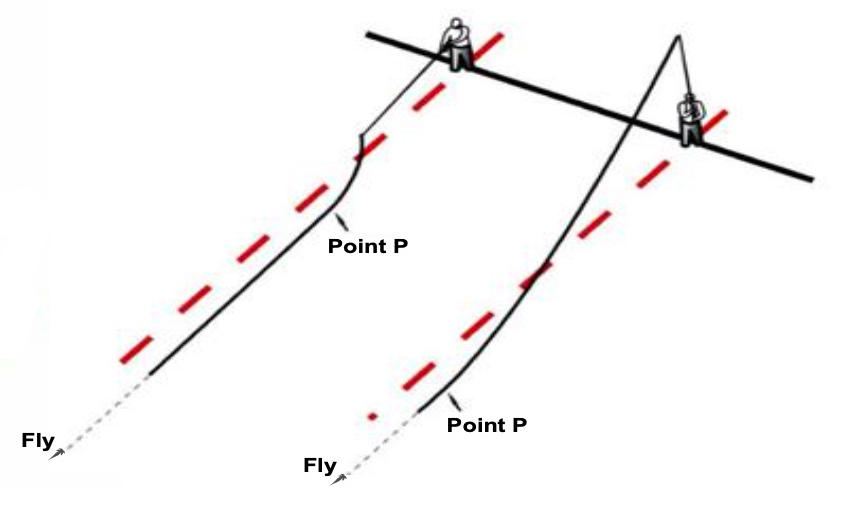

⚫︎コネクション・ポイント: Connection Point
[定義] ラインとリーダー、あるいはラインとシンクティップラインの接続部分。
コネクション・ポイントはしばしばスペイキャスティングにおいて、正しいアンカー設置位置の指標としての言葉として使われる。標準的なコネクション・ポイントは、ターゲットに対してスクエアにスタンスを構える時に45°斜め前、ターゲットラインからロッド一本分離れた地点。 シンクティップラインを使用する時には、シンクティップラインとリーダーの接続部をコネクション・ポイントと見立ててアンカーポジションをセットすることになる。ペリーポークでキャストする場合も同様。
[Definition] The fly line/leader or fly line/sink tip connection.
Connection point is a term often used in Spey casting as an indicator of the correct anchor placement position. The standard connection point is 45 degrees diagonally in front of you when you are standing square to the target, and one rod length away from the target line. When using a sink-tip line, you set the anchor position by regarding the connection point between the sink-tip line and the leader as the connection point.The same applies when casting with a Perry poke.
90度ライン: 90-Degree Line
[定義] キャスターを基点にしてターゲットラインに対して垂直:90 度に引いた仮想線。
アンカードキャストにおいて、ポイントPは90度ラインよりもターゲットより(キャスターの前)に来るようにするのが基本。また、サークルアップに入るのは、ロッドが90度ラインに達したと同時、と言う教え方が一般的。
[Definition] An imaginary line centered on the caster and perpendicular (90 degrees) to the target direction.
In anchored casting, the basic rule is to place Point P beyond the target side (in front of caster) of the 90-degree line. It’s also commonly taught that you should start the circle-up motion as soon as your rod reaches the 90-degree position.

⚫︎Dループ・スイープ: D Loop Sweep
[定義] アンカード・キャストにおいて、バックキャストループ(Dループ)の形成を行うためのキャスティング動作。
Dループ・スイープの質は、アンカード・キャスティング成功の成否を分ける上で最も重要なモーションの一つ。
[Definition] A Casting Stroke which initiates the formation of the back cast Loop of an Anchored Cast.
D loop sweep is one of the most important motions in determining the success or failure of anchored casting.
⚫︎ラインプレースメント動作: Line Placement Move
[定義] Dループ・スイープに備えてフライラインを水面上の適切な位置に置くための、リフト直後のロッドの動作。
ラインプレースメント動作は、サステインドアンカーキャストをする場合の動作。
[Definition] A movement of the rod immediately after the Lift which results in the fly line being positioned appropriately on the water for the subsequent D Loop Sweep.
The line placement motion is used when performing a sustained anchor cast.
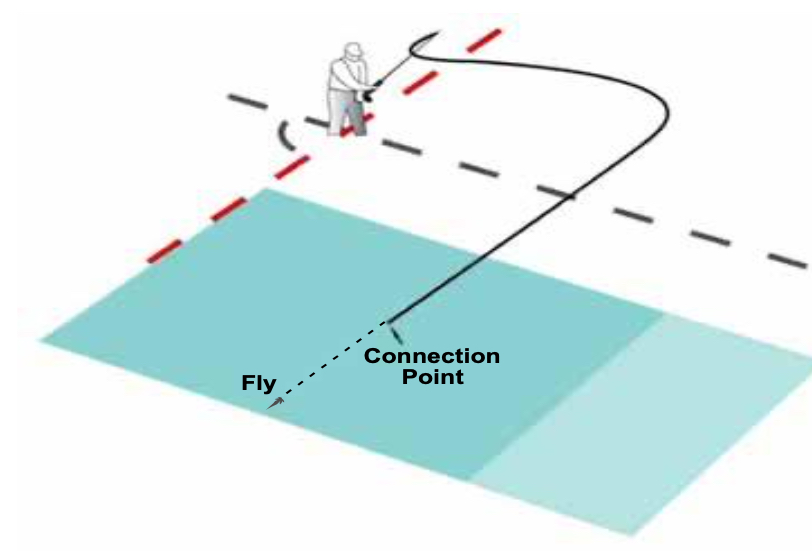
⚫︎サークルアップ: Circle Up
[定義] Dループ・スイープとデリバリー・キャストをつなぐもの。ロッドをキーポジションまで持って行く際の、上向きの円軌道動作。
サークルアップの目的は、1. バックループ(Dループ)の方向がターゲットラインに近づくように方向転換すること。 2. 円運動であるDループ・スイープをテンションを保ったまま直線運動に変換すること。 3.Dループの底部が水に接する部分が長過ぎないようにすること。
[Definition] A circular and upward movement connecting the D Loop Sweep and the Delivery Cast with which the caster moves into the Key Position.
The objectives of the Circle Up are: 1.To redirect the direction of the back loop (D loop) so that it aligns more closely with the target line. 2.To convert the circular motion of the D loop sweep into a linear motion while maintaining tension. 3.To ensure that the bottom of the D loop does not touch the water with too long length.
COD (方向転換) キャスト: Change Of Direction (COD) Cast
[定義] 河川において、流れの向かう方向を0度の基点する時に、30度から120度の角度に向けたラインプレースメントを行うプレゼンテーションをCOD キャストと言う。
基本的には、フライを深いウォーターコラム(水深層)をゆっくりとスイングさせたい時ほど変換角度は大きくする。逆にフライを浅いウォーターコラム(水深層)を早い速度でスイングさせたい時ほど、変換角度は小さくする。
[Definition] In rivers a COD cast is a presentation where the line is placed at an angle of 30 to 120 degrees, with the direction of the current being the base point at 0 degrees.
As a general rule, the deeper and slower you want the fly to swing through the water column, the greater the change-of-direction angle should be. Conversely, when you want the fly to swing faster through a shallow water column, the change-of-direction angle should be smaller.
3大アンカード・ キャスティング・スタイル: 3 Major Anchored Casting Styles
⚫︎トラディショナル・スペイキャスティング: Traditional Spey Casting
発祥:1800年代半ばにスコットランドのリバースペイでのアトランティックサーモン・フィッシングを起点として発達したシングルスペイ・キャスト、ウェールズを起点として発達したウェルシュスロー(ダブルスペイの原型)が、それぞれ個別に発達し、やがてスペイキャストと言う言い方に包括されるようになった。これにロールキャストを加えた3つがアンカードキャストの起源となる。 注:1800年代後期に低角度の方向転換キャストを、鉄道の線路切り替えシステムのスイッチに例えてスイッチキャストと呼んだことからスイッチキャストをアンカードキャストの起源に含むと言う見地もある。
ギアの特徴:元来は20フィート以上のロングロッドにダブルテーパーライン使用であったが、現在はスカジットラインからロングベリーシューティングヘッドまで、また全てのシンクレートのライン種に適するキャスト法になっている。
キャストの特徴: トップハンドはコルクハンドルの上端(ロングロッド、ヘビーライン)、あるいは上端からハンドルの1/3位の間(ショートロッド、ライトライン)に持って来て、キャスティングアークの支点はボトムハンドとトップハンドのほぼ中間地点に来る。これによりトップハンドのストロークが長くなりキャスティングのアーク(回転)角も大きくなることで、ロッドティップの移動距離もロッドにラインウェイトをローディングさせる間合いも長くなる。 トラディショナル・スペイキャスティングの利点は、ラインの推進力が強いので風に強く、大型フライが投げ易く、遠投に有利。 また、ロングラインを扱い易いので、メンディングが広範囲に使える。
Origin: Originating in the mid-1800s on Scotland’s River Spey, the Single Spey cast was developed for Atlantic salmon fishing. Meanwhile, the Welsh Throw—considered the base of the Double Spey—evolved independently in Wales. Over time, these distinct casting styles came to be collectively referred to as “Spey casting.” Along with the Roll Cast, these three techniques form the foundation of modern anchored casting. Note: In the late 1800s, a low-angle directional change cast was likened to a railroad switch system and came to be known as a “switch cast.” From this perspective, some also consider the switch cast to be the origin of anchored casting.
Gear Characteristics: Originally, this style involved casting with long rods over 20 feet and double taper lines. Today, it is compatible with all types of lines and sink rates — from Skagit lines to long-belly shooting heads.
Casting Characteristics: The top hand is placed at the top of the cork handle (long rods, heavy lines), or between the top and about 1/3 of the way down the handle (short rods, light lines), and the pivot of the casting arc comes about halfway between the bottom hand and the top hand.This allows for a longer stroke of the top hand and a wider casting arc, which in turn allows for a longer travel distance of the rod tip and a longer distance for loading the line weight onto the rod. The advantages of the Traditional Spey casting are that the line has stronger propulsion, so it is resistant to wind, easier to cast large flies, and it is advantageous for long-distance casting. Also, because it is easier to handle long lines, anglers can use water mends in wider range.
⚫︎スカンジナビアンスタイル・アンダーハンドキャスティング: Scandinavian-style Underhand Casting
発祥:スキャンディナビアのアトランティックサーモン、トラウトをターゲットとして、1952年、スエーデンのヨラン・アンダーソン氏を起点に発達したキャスト法。
ギアの特徴:ラインの長さは、通常33-40ftのスカンジナビアン・ライン (通称スカンジ・ライン)が使われる。昨今は35ft前後のショートスカンジ・ラインが一般的。また、リーダーにもアンカーとしての役目を担わせるため20-25ftのロングリーダーを使うのが、オリジナルの方法。特徴は、ラインウェイトが長さの割に軽いこと。使われるロッドは、スペイロッドの中では、ファーストテーパーのアクションが中心になる。
キャストの特徴: トップハンドはコルクハンドルの上部から1/3程に短く持ち、ロッドの回転軸の支点はトップハンドの10cm程下に来る。これによりボトムハンドのストロークが長いキャストが成立する。 D-ループはごく浅く取り、またアンカーの長さも極力短く配置した状態から、デリバリーキャストでボトムハンドの瞬発的な”引き”を行うことで、ラインシューティングするのが基本。スカンジナビアン・アンダーハンドキャスティングの有利な点は、ナローループを形成し易い。静かに釣れる、狭いバックスペースの場所で有利、と言う点がある。
Origin: This casting method was developed in 1952 by Sweden’s Göran Andersson, targeting Atlantic salmon and trout in Scandinavia.
Gear characteristics: The length of the line is usually 33-40ft Scandinavian line (commonly known as Scandi). Nowadays, short Scandi lines of around 35ft are common. The original method also uses a long leader like 20-25ft to allow the leader to function as an anchor as well. The line weight is light for its length. The rods used are mainly fast taper action Spey rods.
Casting characteristics: Generally, the top hand grips the rod about one-third of the way down from the top of the cork handle, with the pivot point of the rod’s rotation positioned approximately 4 inches below the top hand. This allows for a longer stroke with the bottom hand during the cast. The D-loop is kept shallow, and the anchor is placed as short as possible. From this set up, the delivery cast is executed with a sharp pulling motion using the bottom hand, shooting a line.
Scandinavian underhand casting is relatively easy to form a narrow loop. It enables quiet presentations and is highly effective in tight spaces.
⚫︎パシフィックノースウェストスタイル・スカジットキャスティング: Pacific Northwest-style Skagit Casting
発祥:1990年代にアメリカ、パシフィックノースウェスト、スカジット川のローカル・スティールヘッダー達がウィンタースチールヘッドを攻略するために開発したラインとフライシステムを効率的にキャスする方法。
ギアの特徴: 川底に張り付いているウィンタースチールヘッドの目の前にフライを通すために、ベタ底をスイングさせることに特化したラインシステムがベース。 20ft前後のひじょうに短いシューティングヘッド・ラインに、10-15ftのT14-17と言ったシンクレートの高いシンクティップラインを接続し、かつフライは極めて比重の高いタングステン・コーンヘッドのついた大きいものも使う、のがベースとなっている。現在は、広範囲なウォーターコラム(水深層) を狙い、ラインの長さのバリエーションでの汎用性が広がっている。
キャストの特徴:これらの道具立ててキャストを成立させるため、まず短いラインだと起こりがちなブロウンアンカーを避けるために深いDループは作らず、高さのあるサークルアップはせず、サステインドアンカーキャストで、シンクティップをしっかり水中に沈めたアンカーを配置する。また、重たいラインの重量をロッドにローディングさせてキャストするために回転運動でコンティニュアス・テンションをラインの重さで保たせるのが特徴。
Origin: A method for efficiently casting a line and fly system developed in the 1990s by local steelheaders on the Skagit River in the Pacific Northwest of the United States to target winter steelhead.
Gear characteristics: The technique is based on a specialized line system designed to swing flies right along the riverbed, passing directly in front of winter steelhead that are hugging near the river bottom. It features a very short shooting head, around 20 feet in length, connected to a high sink rate 10-15ft sink tip line, such as T-14 to T-17. The flies used are typically large and weighted with high-density tungsten cone-heads, allowing them to get down quickly and stay deep. Today, the system has evolved for greater versatility, allowing anglers to target a wide range of the water column by adjusting line lengths and densities to suit various conditions.
Casting Characteristics: To make this setup castable, the technique avoids the blown anchor issues often caused by short lines by not forming a deep D loop or a high circle-up. Instead, it employs a sustained anchor cast, where the sink tip is firmly anchored beneath the water surface. A key feature is maintaining continuous tension through rotational motion, allowing the weight of the heavy line to properly load the rod during the delivery cast.
アンカード・キャストのバリエーション: Anchored Cast Variations
⚫︎ロールキャスト: Roll Cast
[定義] リフト、Dループ・スイープ、サークルアップ、デリバリーキャストから構成される、方向転換を伴わないアンカード・キャスト。フライはデリバリーキャストが終了するまで水面から離れない。
主な用途は、1.バックスペースがない場所。 2.キャストに入る前に、ラインが水面上に真っ直ぐになるようにセットさせるため。 3.障害物に引っ掛かったフライを外す。 4.流し終えて沈んだシンクティップライン、ウェットフライを次のキャストに移行する前に水面近くに持って行き次のキャストの円滑化を図る場合。
[Definition] An Anchored Cast without a substantial change of direction consisting of a Lift, D Loop Sweep, Circle Up, and Delivery Cast in which the fly does not leave the water until after the Delivery Cast.
The main uses are: 1.when backspace is limited; 2.To set up the line so that it is straight on the water before you cast; 3.to free a fly that has snagged on an obstacle; and 4.to bring a sunken sink tip line or wet fly back near the surface after the swing, in preparation for a smoother transition into the next cast.
⚫︎タッチ & ゴー・アンカーキャスト: Touch and Go Anchor Cast
[定義] リフトとそれに続くDループ・スイープの後に、ラインとリーダーがごく短時間だけ接水するキャストの総称。
最も歴史が長いタッチ&ゴー・アンカーキャストは、シングルスペイ。 同義語には、エアボーン・アンカー・キャスト、スプラッシュ & ゴーキャスト、ジャンプロールがあるが、FFI公認の言い方は、タッチ&ゴー・アンカー・キャスト、となる。
[Definition] An Anchored Cast in which the fly line/leader first re-contacts the water after the Lift and D Loop Sweep.
The oldest type of Touch and Go Cast is the Single Spey. Synonyms include “Airborne Anchor Cast,” “Splash and Go Cast,” and “Jump Roll,” but the FFI official term is “Touch and Go Anchor Cast.”
⚫︎サステインド・アンカーキャスト: Sustained Anchor Cast
[定義] Dループ・スイープの前にラインプレースメント動作を行うアンカード・キャストの総称。
最も歴史が長いサステインド・アンカーキャストは、ダブルスペイ。 同義語には、ウォーターボーン・アンカー・キャストがあるが、FFI公認の言い方は、サステインド・アンカーキャスト、となる。
[Definition] An Anchored Cast with a Line Placement Move before its D Loop Sweep.
The oldest type of Sustained Anchor Cast is the Double Spey. A synonym is the “Waterborne Anchor Cast,” but the FFI official term is “Sustained Anchor Cast.”
ダイナミック・ロールキャスト: Dynamic Roll Cast
[定義] トラディショナルなロールキャストと区別するために、「タッチ&ゴー・キャスト」と「サステインド・アンカーキャスト」の両方を包括するアンカード・キャストの総称。
ダイナミックロールキャストは、より速く、より力強いスイープの動作を用いて、従来のロールキャストよりもタイトでより長いラインが空中に保持されるDループを形成することで、デリバリーキャストでのラインスピードと飛距離を向上させる。
[Definition] A general term for anchored casts that includes both the “Touch and Go Cast” and the “Sustained Anchor Cast,” used to distinguish them from the traditional Roll Cast.
The Dynamic Roll Cast uses a faster and more powerful sweep motion to form a tighter and longer airborne D-loop than the traditional Roll Cast, enhancing line speed and casting distance in the delivery cast.
ロールキャスト・ピックアップ: Roll Cast Pick Up
[定義] ロールキャストの射出角を空中に対して行い、ループの展開が空中で完結するようにキャストする方法。
このキャストの目的は主に2つ: 1.ラインを水中からピックアップする時にノイズを減らして静かに処置したい場合。 2.ピックアップしたラインを直ちに空中で方向転換して狙った方向にプレゼンテーションしたい場合。
[Definition] A casting technique in which the roll cast is directed upward into the air, allowing the loop to fully unfold in mid-air.
This cast serves two main purposes: 1.To retrieve a fly that has become snagged on an obstacle. 2.To quietly pick up the line from the water with minimal noise. When you want to pick up the line and immediately change direction in the air to present the fly in the desired direction.
⚫︎スイッチ・キャスト: Switch Cast
[定義] リフト、Dループ・スイープ、サークルアップ、デリバリーキャストからなる、大きな方向転換を伴わないタッチ & ゴー・アンカー・キャスト。
タッチ&ゴー・アンカーキャストに分類される。スペイキャスティングの基礎を構築する時に、最も有効なキャスティング方法。ラインから生じるノイズに敏感な魚には向かないが、手返しよくロングキャストをしたい場合に適する。 尚、スイッチキャストは方向転換を伴わないので、スペイキャストには属さない。
[Definition] A Touch and Go Anchor Cast without a substantial change of direction consisting of a Lift, D Loop Sweep, Circle Up, and Delivery Cast.
Categorized as a touch-and-go anchor cast with no change of direction. It is the most effective casting method when building the foundations of Spey casting. It is not suitable for fish that are sensitive to the noise of the line, but it is suitable for long distance casting that requires quick operation.Note that the switch cast does not involve changing direction, so it is not categorized in Spey casting.
⚫︎スペイキャスト: Spey Cast
[定義] 方向転換を伴うアンカード・キャストの総称。
基本的に、方向転換を伴わないロールキャストとスイッチキャストに対して、方向転換 (COD: Change of Direction Cast)を伴うキャストを指す。方向転換の程度は、比較的低角度のCODにむくSingle Spey (30-70°CODが中心)から、高角度に向くDouble Spey (45-120°CODが中心)、また、あらゆる角度方向をカバーするPerry Pokeなど、川の左岸か右岸か、風向き、使用する道具のペイロード(”シンクティップ+フライの重さ”を運ぶ運搬能力)によって、使い分けられる。
[Definition] An Anchored Cast with a change of direction.
In principle, this refers to a Change of Direction Casts (COD), as opposed to roll cast or switch cast, which do not involve a change in direction. The degree of direction change varies: the Single Spey is best suited for relatively low-angle CODs (typically 30–70°), the Double Spey works well for higher angles (typically 45–120°), and the Perry Poke can cover virtually any angle. Which one you choose depends on factors such as whether you are on the river left or right, the wind direction, and the payload (capacity to carry the combined weight of the sink tip and the fly) of the gear system.
⚫︎シングルスペイ: Single Spey
[定義] 上流側にアンカーを設置し、方向転換を伴うタッチ & ゴー・アンカー・キャスト。リフト、フライラインの位置修正、Dループ・スイープ、サークルアップ、デリバリーキャストで構成される。
用途:タッチアンドゴーアンカーキャスト。手返しが速く、ステルス性に優れる。右手アップの場合、左岸用のキャスト。30~70°のCOD(方向転換)に適する。風のある状況下では、上流への風向きが安全。フローティングライン、またはシンクレートの低いシンクティップライン、小さめのフライに適す。
[Definition] An Upstream Touch and Go Anchor Cast with a change of direction, consisting of a Lift, a fly line repositioning movement, then a D Loop Sweep, Circle Up, and Delivery Cast.
Uses: Touch and Go Anchor cast. Fast and stealthy cast. Casting from left bank method when right hand is up. Ideal to make 30-70° COD (change of direction). In windy condition safer to cast under upstream wind. Best matched with a floating line or a low sink rate sink-tip line and with a smaller-sized flies.
⚫︎ダブルスペイ: Double Spey
[定義] 下流側にアンカーを設置し、方向転換を伴うサステインド・アンカー・キャスト。 リフト、上流方向へのラインプレースメント動作、続いて下流方向へのDループ・スイープ、サークルアップ、デリバリーキャストで構成される。
用途:サステインド・アンカーキャスト。右手アップの場合、右岸用のキャスト。 80~120°のCOD(方向転換)に適する。風のある状況下では、下流への風向きが安全。フローティングラインから沈下速度の速いシンキングラインまで、あらゆるラインでヘビーフライを使用してキャストすることができる。
[Definition] A Downstream Sustained Anchor Cast with a change of direction, consisting of a Lift and an Upstream Line Placement Move, followed by a downstream rod movement transitioning into a D Loop Sweep, Circle Up, and Delivery Cast.
Uses: Sustained Anchor cast. Casting from right bank method when right hand is up. Ideal to make 80-120° COD. In windy condition safer to cast under downstream wind. Suitable to cast with any lines all the ways from floating line to fast sink rate sinking line using heavy flies.
⚫︎スナップキャスト: Snap Cast
[定義] 上流側にアンカーを設置し、方向転換を伴うサステインド・アンカー・キャスト。リフトに続き、ロッドをいったん上流に向けた後に下流側にラインを反転させるラインプレースメント動作、続いて上流方向へのロッド移動から Dループ・ スイープ、サークルアップ、デリバリーキャストで構成される。
oスナップ C/サークル C/サークルスペイ (Snap C/Circle C/Circle Spey)
スナップキャストのラインプレースメント動作において、ロッドを一旦上流側に 持っていき、円を描くように下流に方向に戻す動作をとることで行われるス ナップキャストのバリエーション。
oスナップ T (Snap T)
ロッドを比較的直線的な軌道で一旦上流側に持っていき、そこから下流方 向に鋭角に反転させることでラインプレースメント動作を行うスナップキャスト のバリエーション。
用途:サステインド・アンカーキャスト。右手アップの場合、左岸用のキャスト。45~90°のCOD(方向転換)に適する。 風のある状況下では、上流への風向きが安全。フローティングラインと沈下速度に関わらず、大型で重いフライを使ったシンクティップラインでキャストするのに適する。
[Definition] An Upstream Sustained Anchor Cast with a change of direction, consisting of a Lift, a Line Placement Move in which the rod moves upstream and reverses direction downstream, followed by an upstream rod movement transitioning into a D Loop Sweep, Circle Up, and Delivery Cast.
o Snap C/Circle C/Circle Spey
A Snap Cast where the Line Placement Move consists of the rod moving upstream and reversing direction downstream in a rounded path.
o Snap T
A Snap Cast where Line Placement Move consists of the rod moving upstream and reversing direction downstream in a relatively straight path.
Uses: Touch and Go Anchor cast. Fast and stealthy cast. Casting from left bank method when right hand is up.Ideal to make 45-90° COD. In windy condition safer to cast under upstream wind. Best matched with a floating line or a sink-tip line with a low sink rate, and with smaller-sized flies.
⚫︎スネークロール: Snake Roll
[定義] 下流側にアンカーを設置し、方向転換を伴うタッチ & ゴー・アンカー・キャスト。 ターゲットに向けてロッドティップで円を描くようにリフトし、続いてDループ・スイープ、サークルアップ、デリバリーキャストで構成される。
用途:タッチアンドゴーアンカーキャスト。手返しが速く、ステルス性に優れる。右手アップの場合、右岸用のキャスト。45~90°のCOD(方向転換)に適する。風のある状況下では、下流への風向きが安全。フローティングライン、またはシンクレートの低いシンクティップライン、小さめのフライに適す。
[Definition] A Downstream Touch and Go Anchor Cast with a change of direction, consisting of a Lift with a circular movement towards the target, transitioning into a D Loop Sweep, Circle Up, and Delivery Cast.
Uses: Touch and Go Anchor cast. Fast and stealthy cast. Fishing from right bank method when right hand is up. Ideal to make 45-90° COD (change of direction). In windy condition safer to cast under downstream wind. Best matched with a floating line or a low sink rate sink-tip line and with a smaller-sized flies.
⚫︎ペリーポーク: Perry Poke
[定義] ラインのスラックを前方、投げたい方向に置き直してアンカーとし、続いてDループ・スイープ、サークルアップ、デリバリーキャストで構成されるキャスト。
用途:サステインド・アンカーキャスト。右手アップの場合、左岸用のキャスト。あるゆる角度のCOD (方向転換) のキャストに向く。 風のある状況下では、上流への風向きが安全。発祥はパシフィックノースウエストのウィンタースチールヘッダー達が、重いシンクティップのシューティングヘッドとヘビーフライをキャストするために開発したキャスト方法。このキャストはアンカー設置の位置が誤ってずれた場合のジェイルブレイク(脱出用キャスト)としても広く使われる。
[Definition] A rod movement which directs slack fly line on the water in front of the caster approximately in line with the target direction, and is then followed by a D Loop Sweep, Circle Up and Delivery Cast.
Uses: Sustained Anchor cast, suitable for in any angle of COD (Change of Direction) cast.When you cast with right hand up this is a left bank cast. In windy condition safer to cast under upstream wind. It originated as a casting method developed by winter steelheaders in the Pacific Northwest to cast heavy sink-tip shooting heads and heavy flies. This cast is commonly used as a Jail Break for the anchor mis-placement.
⚫︎ダウンストリーム・アンカーキャスト: Downstream Anchor Cast
[定義] 流水ではアンカーとDループをキャスターの下流側に、静水ではキャスターから見てリフト前にラインがあった場所と同じ側にアンカーとDループを配置させてから行うアンカード・キャスト。
[Definition] An Anchored Cast which in moving water places the Anchor and D Loop downstream of the caster, or in still water leaves them on the same side of the caster as the fly line before the Lift.
⚫︎アップストリーム・アンカーキャスト: Upstream Anchor Cast
[定義] 流水ではアンカーとDループをキャスターの上流側に、静水ではキャスターから見てリフト前にラインがあった場所とは反対側にアンカーとDループを配置させてから行うアンカード・キャスト。
[Definition] An Anchored Cast which in moving water places the Anchor and D Loop upstream of the caster, or in still water places them on the opposite side of the caster from the fly line before the Lift.
アンカード・キャスティングのミス: Anchored Casting Faults
アンカー設置ミス: Misplaced Anchor
[定義] アンカーの設置位置が前すぎ、または、後ろすぎ、あるいは、上流すぎ、または下流すぎる位置にセットされた場合、あるいは、アンカーが途中でターゲットラインから外れて極端に湾曲している場合。
[Definition] If the anchor is placed too far forward, backward, upstream, or downstream, or if anchor deviates significantly from the target line midway and becomes excessively curved.”
長すぎる/短かすぎるアンカー: Too long/short fly line in anchor
[定義] アンカーの長さが長すぎる、あるいは短かすぎるエラー。
タイミングの取り方のズレから生じる場合などが原因。
[Definition] Anchor length too long and too much line sticking on the water. Or too
short, which may cause the blown anchor.
This error is often refer to the wrong timing.
⚫︎ブラディーL・アンカー: Bloody L Anchor
[定義] アンカーの先端が、 Dループに対してほぼ直角に曲がってしまうミス。
ブラディーL・アンカーはキャストのミスだけと思いがちだが、シンクティップラインを使用している場合、ダブルスペイ、スナップキャストのアンカープレースメントでは水中のラインが見えず、水中で L字にラインが留まっている可能性も考慮する必要がある。
[Definition] A fault where an Anchor has some of the fly line/leader positioned at approximately a right angle to the remaining Anchor.
It is easy to think that the Bloody L anchor is a casting error, but when you are using a sink-tip line, you need to consider the possibility that the line may be in an L shape underwater when placing the anchor in a double spey or snap cast, as the line may not be visible underwater.
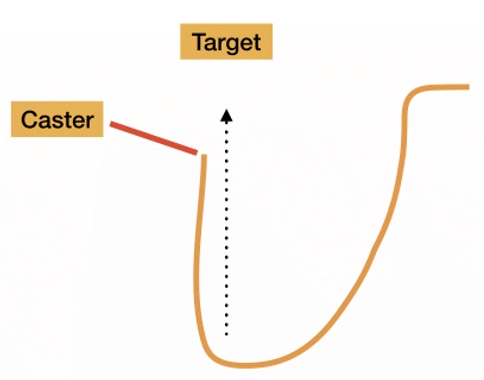
⚫︎ブロウン・アンカー: Blown Anchor
[定義] デリバリーキャスト中にアンカーが早過ぎるタイミングで離水してしまうミス。
[Definition] A fault where an Anchor prematurely releases from the water during the Delivery Cast.A fault where an Anchor prematurely releases from the water during the Delivery Cast.
日本では通常「アンカー切れ」と呼んでいる言葉。
⚫︎パイルド/クラッシュト・アンカー: Piled/Crashed Anchor
[定義] ライン、リーダーが着水した際に、スラックが生じてしまっているアンカーの設置ミス。
[Definition] A fault where an Anchor lands on the water creating slack in the fly line/leader.
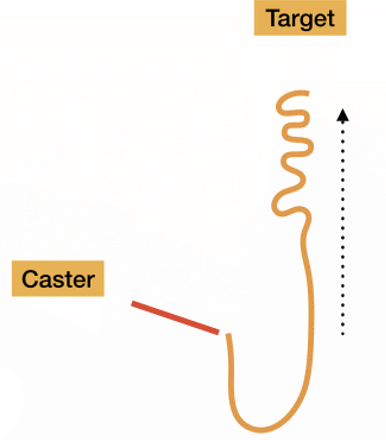
⚫︎スキップト・アンカー: Skipped Anchor
[定義] アンカーが一時的に形成されたあと、デリバリーキャストの前に再度水から離れて後方にラインが飛んでいってしまうミス。
[Definition] A fault where an Anchor briefly forms and then prematurely leaves the water while moving away from the target before the Delivery Cast.
⚫︎レベルライン・ドロップ: Level Line Drop
[定義] Dループ形成時のスイープで、フライライン、リーダーが水面に平らな状態で同時に着水してしまうアンカーの設置ミス。
[Definition] A fault in the D Loop Sweep which causes the fly line/leader to land flat on the water.
スキュード・アンカー: Skewed Anchor
[定義] フライライン先端部が、ターゲットラインから離れた方向を向いているアンカー。非効率的なアンカー設置で、ライン先端がキャスター側に湾曲している時にはキャスターにとって危険な状態となり得る。
[Definition] An anchor with the front part of the fly line pointing away from the target line. Inefficient and possibly dangerous if pointed toward the caster.
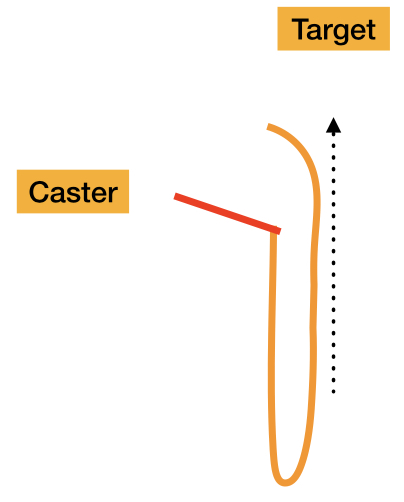
クロスド・アンカー: Crossed Anchor
[定義] Dループの反対側でキャスターの前を横切るアンカー。フライがキャスターに引っかかるリスクが高い、非常に危険なアンカー設置の状態。
[Definition] An anchor which crosses in front of the caster on the
opposite side from the D loop. Very dangerous anchor fault with a high risk of the fly hooking the caster.
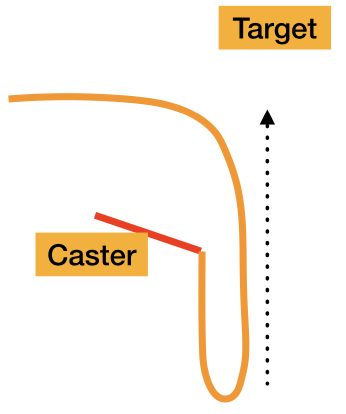
⚫︎トランキング: Trunking
[定義] Dループ形成時のスイープの終了間際に、ロッドティップを下向きに動かしてしまったことで、アンカーが長くなり過ぎて着水し、ポイント P がキャスターの後ろに来てしまうというアンカーの設置ミス。
[Definition] A fault where downward rod tip movement at the end of the D Loop Sweep results in an Anchor which is too long, with Point P behind the caster.
⚫︎フッキング: Hooking
[定義] Dループをキャスター後方に回り込むような形で形成してしまうミス。
[Definition] A fault where the D Loop swings around and behind the caster.
アンカープレースメント失敗時のジェイルブレーク: Jailbreaks in Anchor Mis-placement
[定義] アンカーを誤った位置に設置してしまった場合の“脱出方法 (ジェイルブレイク)”。
例えば、アンカーが上流すぎる位置に置かれてしまった時は、キャスティングの角度を変えてより上流に向けて投げる、ペリーポークやスネークロールに切り替える、または単純にやり直すといった方法がある。逆に、アンカーが下流すぎる位置にある場合は、デリバリーの角度を調整する、スナップキャストやロールキャストでラインをダングル(下流に真っ直ぐに垂れ下がった状態)に戻してからやり直す、などの方法が有効になる。
[Definition] Ways to get out of an anchor mis-placement.
For example, when the anchor was placed too far upstream, changing your casting angle to aim more upstream, switching to a Perry Poke or Snake Roll, or simply starting over. When the anchor was placed too far downstream, changing the delivery angle or using a Snap Cast, roll cast to dangle and starting over.
ティーチング基本用語: Basic Teaching Terms
ティーチングのエッセンス: Essence of Teaching
6ステップ教授法: The Six-steps Teaching Method
ブルース・リチャード氏の考案によるフライキャスティングのシンプルで効果的な教授法。 原因分析:①ライン → ②ロッド →③ボディ(体=手首・腕など)、解決策と修正方法:④ボディ→⑤ロッド→⑥ライン、の6ステップの手順を踏むことによって、インストラクターはキャスティングの問題を論理的に分析し、生徒が理解しやすい形で解決策を伝えることができる。このシンプルなアプローチにより、生徒は改善を実感できるようになり、また、自分のキャスティングがなぜ変化したのかを理解できるようになる。
6ステップ・ティーチング法の流れ
1. 問題がどこにあるのかをトップダウンのフローで分析 (適用例:初心者のワイドループの修正)
① ライン:まず、どのような問題がラインに現れているのかを説明する。「見てください。このようにワイドループになっていますね。」
② ロッド:ロッドの動きがどのように影響して、ラインに現れた問題を引き起こしているのか、を説明する。「このワイドループは、ロッドの先端が大きな弧を描いて動くことで生じています。」
③ ボディ:生徒の体の動きが、ロッドの誤った動きを引き起こしている原因を説明する。「あなたの手首が大きく曲がっているため、ロッドの先端が大きな弧を描いてしまっています。」
2. ボトムアップのフローで解決策を教える
④ ボディ:どのように体(手首・腕など)を動かせばよいかを説明する。「手首をあまり曲げないようにしましょう。」
⑤ ロッド:正しい体の動きによってロッドがどのように変化するのかを説明する。「すると、ロッドの先端がより直線的に動くようになりますね。」
⑥ ライン:ロッドの適切な動きによって、どのようにラインの問題が解決するのかを説明する。「見てください!ループがナロー(狭く)になりました。」
A Six Step Method, Bruce Richards, The Loop, Spring 1999.
A simple and effective teaching method for fly casting devised by Bruce Richards. By following a six-step process of cause analysis: ① Line → ② Rod → ③ Body (body = wrists, arms, etc.), solutions and corrections: ④ Body → ⑤ Rod → ⑥ Line, instructors can logically analyze casting problems and communicate solutions in a way that is easy for students to understand. This simple approach allows students to see their improvement and understand why their casting has changed.
The Flow of “The Six-Step Teaching Method”
- Top-Down flow to analyze the Problem
Example: Correcting a Wide Loop in a Beginner’s Cast
① Line: First, identify and explain the problem as it appears in the fly line.
“Look at this. You can see that your loop is too wide.”
② Rod: Explain how the rod’s movement is causing the issue in the line.
“This wide loop happens because the tip of your rod is moving in a big arc.”
③ Body: Identify how the student’s body movements (wrist, arm, etc.) are contributing to the incorrect rod movement.
“Your wrist is bending too much, causing the tip of the rod to move in a wide arc.”
- Bottom-Up flow to correct the problem
④ Body: Explain how the student should adjust their body movements.
“Try to keep your wrist straighter and avoid excessive bending.”
⑤ Rod: Describe how this adjustment will change the rod’s movement.
“Now, the tip of your rod will move in a straighter path.”
⑥ Line: Show how these corrections improve the line’s performance.
“Look at that! Your loop has become tighter and more efficient.”
ティーチングにおける3つのコミュニケーション方法: Three Communication Methods in Teaching
生徒の求めるスタイル、キャスティング上の問題点は百人百葉。その時の最適なコミュニケーションとアプローチによるティーチングで生徒と接すること。 以下の3つの内最善と思われる接し方を選びことができる。
A: 口頭説明:言葉で説明する。
B: 視覚に訴える説明:例えば、インストラクターが、誇張気味の悪い例を実演する。良い形、悪い形のループをそれぞれ投げて見せる。道具や、図表などを使って説明する、等々。
C:体の運動感覚に訴える説明方法: ドリルを提供して体の使い方の反復練習をする。インストラクターが、生徒のロッドに手を添えて間違った動き、正しい動きを体感させてわかってもらう、等々。
Each student has their own preferred style and unique casting issues. It is important to engage with them through the most suitable communication and approach at that moment during teaching. The following are three main methods of approaching your student, from which the best one can be selected depending on the situation:
A: Verbal approach: Explain concepts using words.
B: Visual approach: For example, the instructor demonstrates exaggerated poor examples. Showing both good and bad casting forms repeatedly. Use tools like equipment or diagrams for explanation.
C: Kinesthetic approach: Provide drills for repeated physical practice. The instructor may place their hands on the student’s rod to help them physically experience incorrect and correct movements, aiding in understanding through physical sensation.
サブスタンスとスタイル : Substance and Style
サブスタンスとは、基本原理、基礎を意味する。一方、スタイルとは、手法を意味する。最も効率的なキャスティングを成立させる時に、ロッドは、一つのキャスティング・プレーンを通る、ロッドティップは直線状の軌道を通る、と言った概念は、キャスティングの本質的な原理であって、個人の好みによって変動するものではない。これをサブスタンスと言う。一方で、使うロッドやラインのアクションやタイプ、それに伴って変化するキャストの手法、グリップ、スタンス、等々、それぞれ個人の個性や好みによる違いがあるが、これをスタイル、と言う。このサブスタンスとスタイルの意味の違いを認識した上で生徒と接することが、インストラクターには求められる。
“Substance” refers to the fundamental principles and the essential foundation of fly casting. On the other hand, “Style” refers to the specific methods or techniques used. When performing the most efficient cast, concepts such as the rod moving along a single casting plane or the rod tip traveling in a straight-line path are core principles of casting. These are not subject to personal preference and are considered the Substance of casting.In contrast, variations in methods such as the type or action of the rod and line used, grip, stance, and other aspects influenced by individual preferences or characteristics are referred to as Style.It is essential for instructors to understand and distinguish between substance and style when working with students.
時計によるキャスト角表現システム: The Clock and Angle System
3つのロッドの位置を説明する、仮想時計の文字盤配置。
- 方向時計: 時計の文字盤は地面や水面に水平に置かれ、12時がキャスターが向いている方向。1時なら右に30°。
- 仰角時計:時計の文字盤はキャスターとターゲットを結ぶ線上に垂直に立てかけられ、12時はロッドが垂直、9時はロッドをターゲットに向けて水面と平行、3時は後方に水平を意味する。
- ロッドプレーン時計:時計の文字盤はターゲットラインに対して直角(スクエアに)かつ垂直に立てかけられ、12時が垂直面、3時はキャスターの右側の水平面となる。
Three common imaginary clock faces to describe rod positions.
- Direction Clock: The face of clock is flat on the water with 12 o’clock in the direction the caster is facing. 1 o’clock is 30 degrees to the right and so forth.
- Rod Elevation Clock: The face of clock is along the caster to target line. 12 o’clock represents a vertical rod, 9 o’clock denotes a rod parallel to the ground or water pointed at the target, and 3 o’clock means horizontal behind.
- Rod Plane Clock: The face of clock is placed square to the target line with 12 o’clock vertical and 3 o’clock (90 degrees) horizontal to the caster’s right.
90度ライン: 90-Degree Line
[定義] キャスターを基点にしてターゲットラインに対して垂直:90 度に引いた仮想線。
[Definition] An imaginary line centered on the caster and perpendicular (90 degrees) to the target direction.

ピックアップ・アンド・レイダウン (PULD) : Pick Up and Lay Down
[定義] 「リフト → バックキャスト → ポーズ → フォワードキャスト → ポーズ → レイダウン」のワンサイクルを通して、キャスティングの基礎を学ぶ基本形。
通常、ピックアップ・アンド・レイダウンは、オーバーヘッドキャスティングの基礎を教える時に用いられるが、この概念は、オーバルキャスト、スイッチキャストの基礎学習に適用しても十分な意味を持つ。
[Definition] Through the cycle of “Setup → Lift → Back Cast → Pause → Forward Cast → Pause → Lay Down,” students learn the fundamental mechanics of casting.
The Pick Up and Lay Down is typically used to teach the basics of overhead casting, but the concepts are equally valid when applied to learning the basics of oval cast, and Switch Cast.
トライアングル・メソッド: Triangle Method
[定義] イギリスのリー・カミングスが提唱するキャスティング練習のドリル。キャスターの前に2個のコーンを置き、キャスターとそのコーンを結んだ三角形がほぼロッドの長さの正三角形になるように設定する。キャスターは、目の前に置かれたスクエアに置かれたコーンの間を地面と並行にサイド(アーム)キャストでフォルスキャストをする。正しいキャスティング・プレーンの習得、ストレート・フライレグへの矯正、ナローループのエッセンスを掴み易い、等々、効率のいい基礎の構築に結びつけることができる。
[Definition] “A casting drill developed by Lee Cummings from the UK. Two cones are placed in front of the caster, forming an equilateral triangle with the caster where each side is roughly the length of the rod. The caster performs false casts with a side arm cast, keeping the line parallel to the ground and between the cones placed in the square in front of them. This drill helps develop an accurate casting plane, corrects the fly leg into a straight line, and makes it easier to grasp the essence of a narrow loop—leading to an efficient foundation in casting skills.
ラインマネージメント・テクニック: Line Management Techniques
[定義] デリバリーキャストが完了したあと、ラインリトリーブに入るが、その際、次のキャストにおいてライン絡みがない状態でキャストに入れるラインの整理、管理をする方法。また、特にソルトウォーターフィッシングにおいては、ターゲットフィッシュのストライクと同時に急速度で走られることになるが、その際に足元のラインがリールファイトに持ち込むまで、トラブルがなく出て行く準備をしておくことへの配慮を言う。
スペイフィッシング: モダンスペイフィッシングでは、シューティングヘッドを使うことが多く、その際ランニングラインはナイロンモノフィラメントになることが多い。ナイロンモノフィラメントは、水離れが良く遠投性能が高いが、絡むリスクもあり、小指、薬指、中指と順々にコイルを作ってリトリーブするやり方が基本になる。
ソルトウォーターフラッツ: フラッツボート(スキッフ)からキャストする場合は、船首のプラットフォームからキャストすることが多い。その際、リトリーブしたラインは、プラットフォームに落とすのではなく、ボートデッキに落とす。その際、その周辺にラインが引っ掛かる障害物が無いこと、ラインの一部がボートの外に出ていないことがポイントになる。 一方で、フラッツをウェーディングで釣る際には、潮に流されるラインがシューティングの距離のコントロールを妨げること、足元のラインをシューティングする際の水離れのノイズがターゲットフィッシュを警戒させることも考慮しなければならない。
[Definition] After completing a delivery cast, anglers begin retrieving the line. During this process, it’s important to organize the line in such a way that the next cast can be made without tangles. This preparation ensures smooth casting. In particular, during saltwater fishing, when a target fish strikes and takes off at high speed, it’s essential to have specific concerns the line at your feet arranged so it can run out smoothly without any issues until the fight is brought to the reel.
Spey Fishing: In modern Spey fishing, shooting heads are commonly used, and the running line is often made of nylon monofilament. Nylon monofilament offers excellent water shedding and long-distance casting performance, but it also carries a higher risk of tangling. To manage this, the basic technique is to retrieve the line by forming coils sequentially with the pinky, ring, and middle fingers.
Saltwater Flats: When casting from a flats boat (skiff), anglers typically cast from the platform at the bow. In this case, the retrieved line should not be dropped onto the platform, but rather onto the boat deck. It’s important to ensure that there are no obstacles around that the line could snag on, and that no part of the line is hanging outside the boat. On the other hand, when wade fishing on the flats, anglers need to be mindful of the current pulling on the line, which can interfere with shooting distance control. Additionally, the noise caused by the line shedding water as it is shot from the feet can spook target fish, so that must also be taken into consideration.
エチケット: Etiquette
釣り人にとってのエチケットとは、お互いが気持ちよく釣りが出来る振る舞い、と言う概念を越えて私たちが追い求める魚達が棲んでいる自然環境を守るための意識的な行動をも含みます。
尊敬される良識あるアングラーは、釣りという行為そのものに加え、それを取り巻く生態系やコミュニティとの深い関わりを持ちながら、釣りの楽しみを次世代へ持続可能な形で受け継いでいく姿勢を示してくれるものです。 そのためには、その場その場に応じた行為に対しての想像力を伴った思いやり、自主的な判断力が求められます。迷ったときには、あなたが尊敬するフライフィッシャーや、プロのフライフィッシングガイドが、しばしば言葉にされないこれらの行動規範を指し示す羅針盤のような存在になってくれるはずです。 加えて私たち一人一人が規範となって後輩に伝えていくことが望まれるものとも言えます。 (Hiro Masaki, MCI)
A) 釣り場を共有する人達
1. 釣り場で合う他の釣り人に対して
2. あなたの釣りのパートナーに対して
3. あなたのガイドに対して
4. 釣り以外の目的で訪れている人達に対して
B) 釣り場環境に則したエチケット、ルールの理解。
1. トラウトリバー、スプリングクリークでのドライフライ、ニンフ・フィッシングの場合
2. スペイ(スイング)フィッシングを行う川の場合
3. レイクフィッシングの場合
4. ソルトウォーター、スキッフ(フラッツボート)の場合、オフショア・ボートフィッシングの場合
5. ソルトウォーター、フラッツウェーディングの場合、ショアフィッシングの場合
C) キャッチした魚の扱い
1. 川を管理する機関のローカルルールの把握
2. 魚のダメージを抑えるノウハウ(バーブレスフック、ファイティング時間の短縮法、ティペットのポンドテストに対する考え方、キャッチした魚のランディング/ホールディングの仕方、リリースの仕方、計測方法)
3. 写真撮影の心得
D) 自然環境保護
1. 廃棄物の処理(使用済のライン、食事のゴミ)
2. 植物、海では珊瑚を含む生き物に対する扱い
3. 他の釣り人が廃棄したラインの回収
For anglers, etiquette goes beyond simply being thoughtful and respectful toward others—it also involves mindful actions that help protect the natural environment, especially the habitats of the fish we seek.
To be a truly conscientious angler means not only engaging in the act of fishing, but also forming a deeper connection with the surrounding ecosystem and community. It’s about fostering an approach that ensures the joy of angling can be sustainably passed on to future generations.
This mindset requires imagination, empathy, and independent judgment. When you’re uncertain, look to those you respect—seasoned fly fishers or professional guides can serve as invaluable sources of insight and direction. Hopefully, we’ll become the ones who set the standard and pass these values on to those who follow. (Hiro Masaki, MCI)
A) Respect for Others Sharing the Water
- To the fellow anglers you encounter on the water
- To your fishing partner
- To your guide
- To non-angling visitors to the area
B) Understanding Etiquette and Rules Specific to the Fishing Environment
- Dry fly and nymph fishing on trout rivers and spring creeks
- Swing (Spey) fishing in rivers with shared runs
- Lake fishing—whether from a boat or from the shore
- Saltwater boat fishing—Flats fishing from a skiff, Off-shore boat
- Wading in the saltwater flats, fishing from the shore
C) Handling of Caught Fish
- Awareness of local rules and regulations enforced by river authorities
- Best practices for minimizing fish harm: using barbless hooks, reducing fight time, thoughtful tippet selection, safe landing, proper handling and release techniques, and methods when measurement is required
- Ethical fish photography: keep fish wet, fast, and close to the water
D) Environmental Stewardship
- Proper disposal of waste—used tippet, leaders, food wrappers, etc.
2. Respect for all living organisms, including plants and coral in marine areas
3. Picking up discarded lines left by other anglers
釣り場: Fishing Sights
⚫︎川の左手/左岸: River Left/Left Bank
[定義] 下流に向かって川の左手、左手側の岸。
[Definition] The left bank of the river when facing downstream.
⚫︎川の右手/右岸: River Right/Right Bank
[定義] 下流に向かって川の右手、右手側の岸。
[Definition] The right bank of the river when facing downstream.
ウォーターコラム: Water Column
[定義] 魚がフィーディングしている泳層、または、フライを流す水深のレイヤー層。 水面に近い方から、水面(サーフェス)、水面直下 (サブサーフェス)、中層(ミッドウォーター)、低層(ロウアーレイヤー)、底 (ボトム) で表現される。
スイングフィッシングでは、ボトム近くのウォーターコラム(水深層)では水面の水流より遅いことが多いことを気に留めておく必要がある。つまり、水面上のラインの先端の位置に対してフライの位置はずっと上流にある、と言う場合が殆どになる。
[Definition] Water Column is the layers where fish are feeding, or the depth layers where the fly drifts. From the surface down, the Water Columns are described as: Surface, Subsurface, Mid-Water, Lower Layer, Bottom.
It is important to remember that when swing fishing, the water column near the bottom is often moving slower than the surface, so your fly will often be far upstream from the end of your fly line.
ダウンストリーム・ウィンド : Downstream Wind
[定義] 下流に向かって吹く風。
[Definition] A wind that blows downstream.
アップストリーム・ウィンド : Upstream Wind
[定義] 上流に向かって吹く風。
[Definition] A wind that blows upstream.
フラッツ : Flats
[定義] フラッツとは、通常は海水域にある浅くて広い水域を指し、ボーンフィッシュ、パーミット、レッドフィッシュ、日本ではクロダイなどの魚が見られる場所のこと。
通常、フラッツの魚は警戒心がひじょうに高く、餌を探して高速で移動しているのが普通。 よって高度のSWQC (ソルトウォーター・キャスト) のキャスティング技術が要求される。
[Definition] Flats typically refers to shallow, wide area of water, usually in saltwater regions, where fish like bonefish, permit, and redfish are commonly found.
Flats fish are usually extremely cautious and tend to move fast while foraging, which requires precise and advanced casting skills, which is called as SWQC (Saltwater Quick Cast).
ナーバスウォーター、Vウェーブ、テイリング : Nervous Water/V Waves/Tailing
[定義] 主にフラッツ・フィッシングにおいて、「ナーバスウォーター」とは、魚が水面下を餌を追って動く時に、水面が攪拌されることによって起こる魚の気配、もじり。 「Vウェーブ」とはターゲットフィッシュが、直線状に水面下を移動する時に、舟の航跡のように水面に現れるV字状の波紋。日本では引き波とも言う。「テーリング」とは、ボーンフィッシュやクロダイのような魚が底で餌を探す際、尾びれが水面から突き出る行動を指す。
Vウェーブによって、ターゲットフィッシュの進行方向察知し、テイリングしている魚の尾鰭の角度によって水中の魚の頭の位置を判断し、ナーバスウォーターを見つけることにより、視線を水中に向けて周辺を泳ぐ魚の位置をいち早く察知することにより、極端に警戒心の高いフラッツの魚の進行方向に先回りして、いかにフライを極力静かにプレゼンテーションできるか、がフラッツフィッシングのキーポイントとなる。
[Definition] Mainly in flats fishing, “nervous water” refers to subtle surface disturbances or ripples caused when fish move just beneath the surface while chasing prey. “V waves” are V-shaped wakes that appear on the surface, like the wake of a boat, when a target fish moves in a straight line just below the water. “Tailing” describes the behavior of fish, such as bonefish or black sea bream, whose tail fins break the surface as they search for food along the bottom.
By reading the direction of a target fish from its V waves, judging the position of its head underwater from the angle of the tail when it is tailing, and spotting nervous water to quickly locate fish swimming nearby, an angler can get ahead of the path of the extremely wary fish on the flats. The key to flats fishing lies in presenting the fly as quietly as possible in that anticipated path.
FFI キャスティング用語定義集編成チーム: Fly Casting Education Program Definitions Team
| 定義集編成チームの共同議長: Definitions Team Co-Chairs |
| Bryan Martin, MCI/THMCI, Bruce Williams, MCI/THMCI |
| Sekhar Bahadur, MCI/THMCI |
| Mac Brown, MCI |
| Mark Huber, MCI/THMCI |
| Bob Young, MCI |
| FFI フライ キャスティング教育プログラム リーダーシップ チームと内容審議に携わった方々。 |
| With thanks to the FFI Fly Casting Education Program Leadership Team and our reviewers: |
| Bill Higashi, MCI/THMCI |
| Willie Holmes, MCI/THMCI |
| Tim Rajeff, MCI/THMCI |
| Todd Somsel, MCI/THMCI |
| Mark Surtees, MCI |
| グラフィックと図表を担当、Bintoro Tedjosiswoyo, CI/THMCI 。 |
| Special thanks to Bintoro Tedjosiswoyo CI, THMCI for the graphics and diagrams. |
| フライキャスティング・メカニックスチーム / FFI Fly Casting Mechanics Team |
| Sekhar Bahadur, MCI/THMCI, Chair |
| John Bilotta, MCI/THMCI |
| Vince Brandon, CI |
| Mac Brown, MCI |
| Craig Buckbee, MCI |
| Willy George, MCI/THMCI |
| Bill Higashi, MCI/THMCI |
| Graeme Hird, MCI |
| Lasse Karlsson, MCI/THMCI |
| Malik Mazbouri, CI |
| Bruce Richards, MCI |
| Mark Surtees, MCI |
